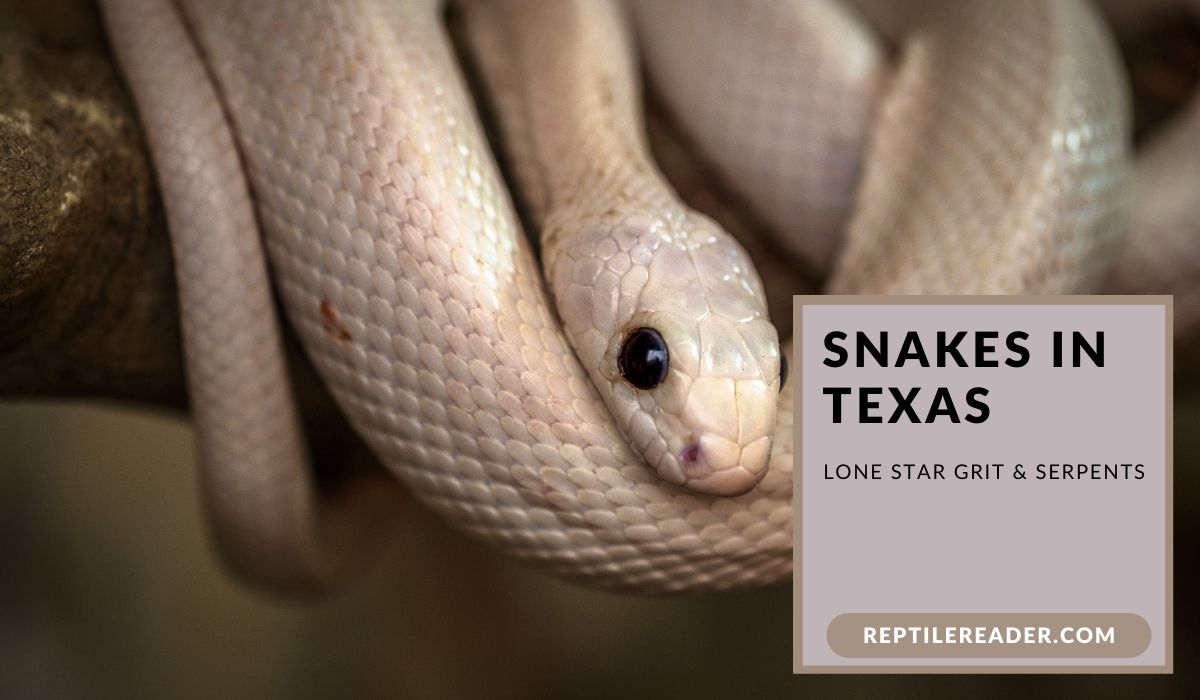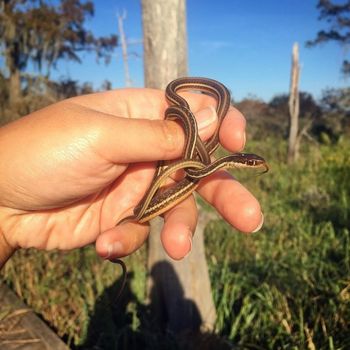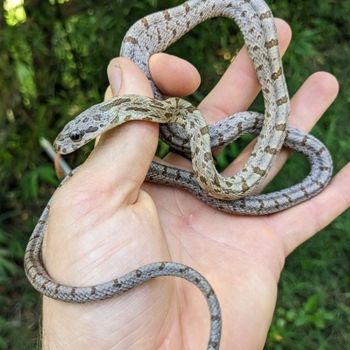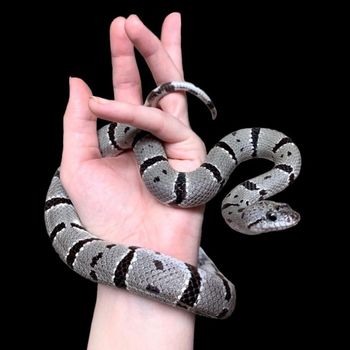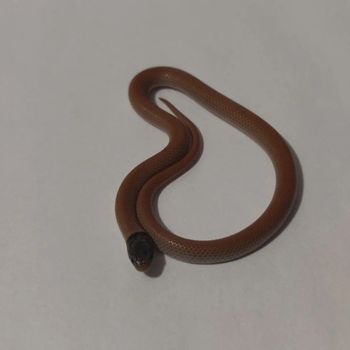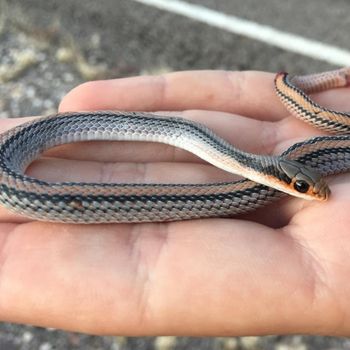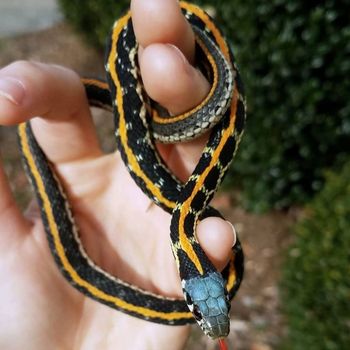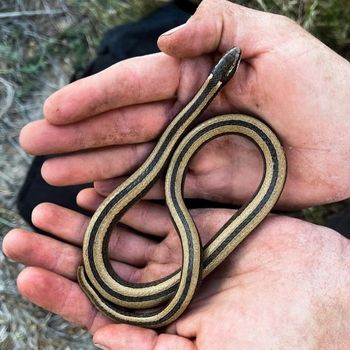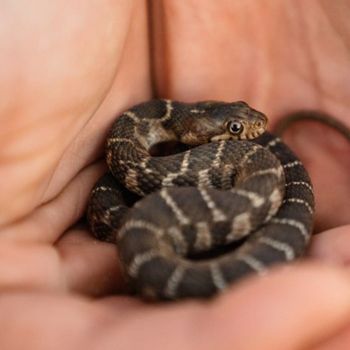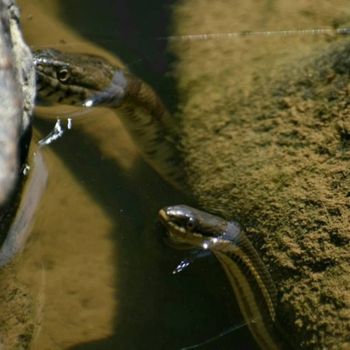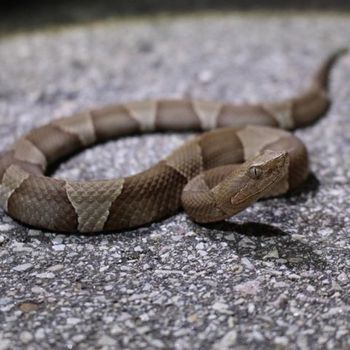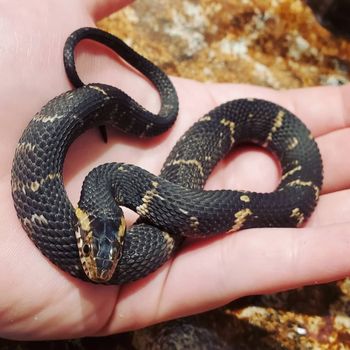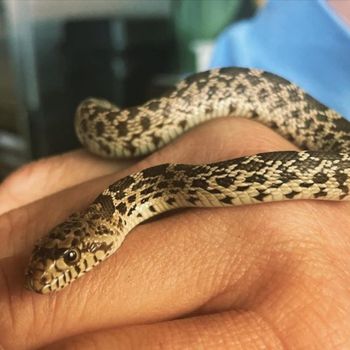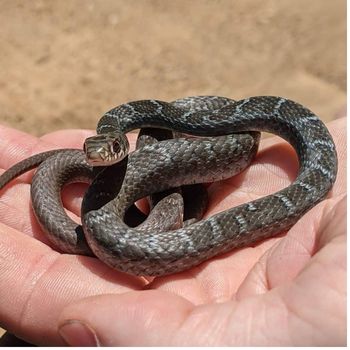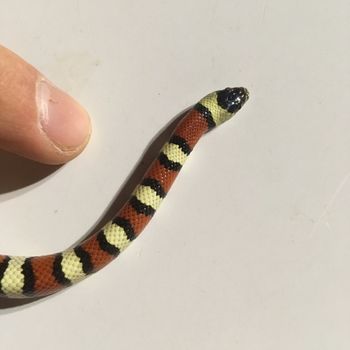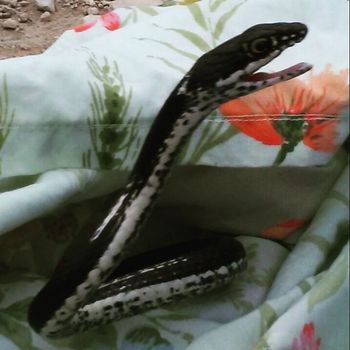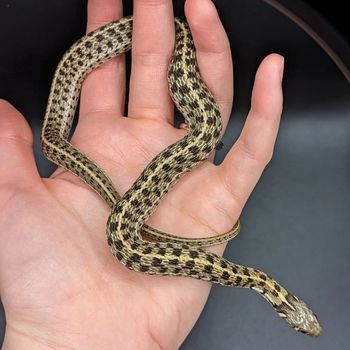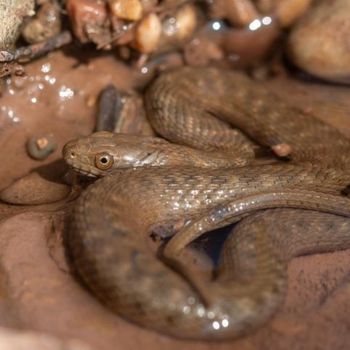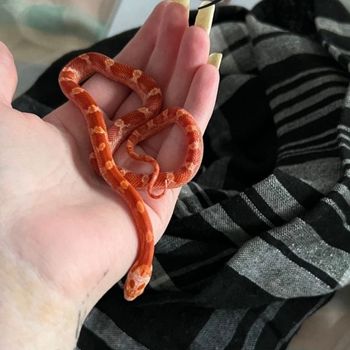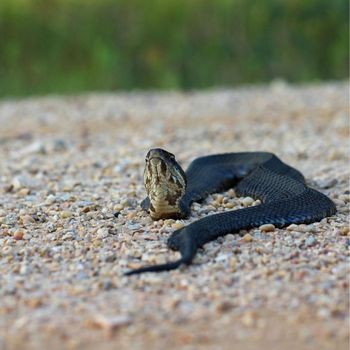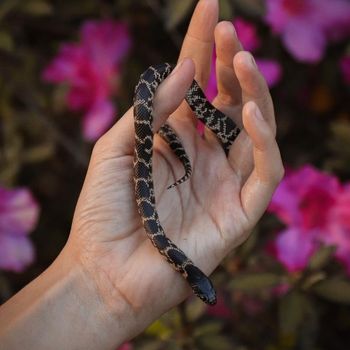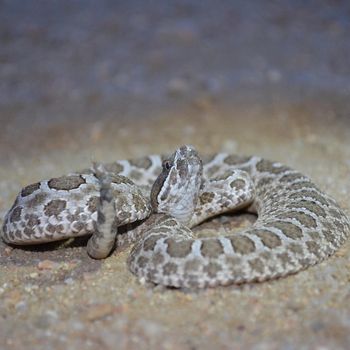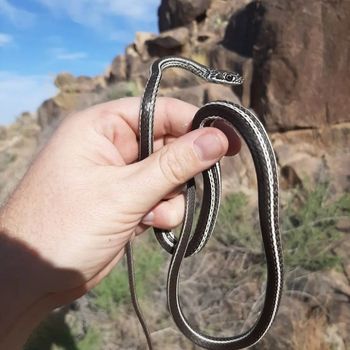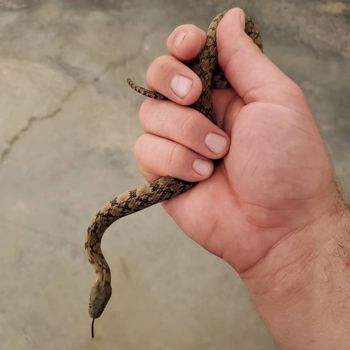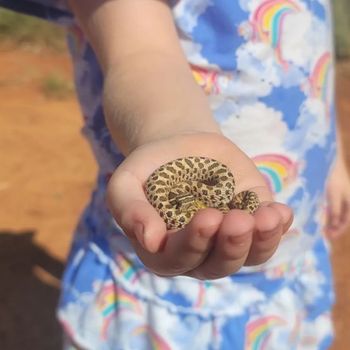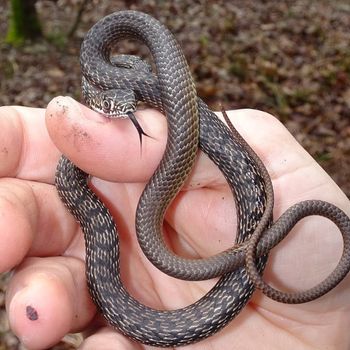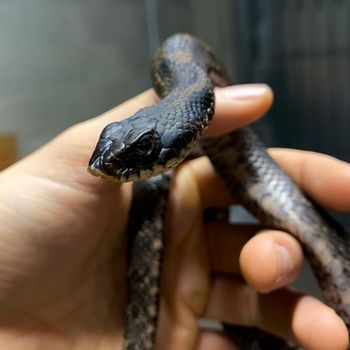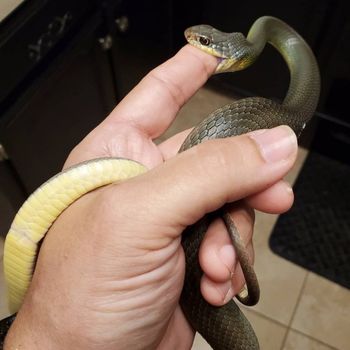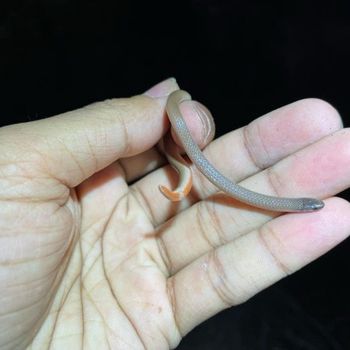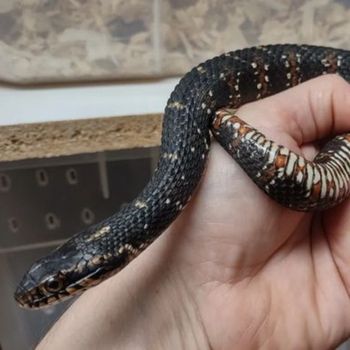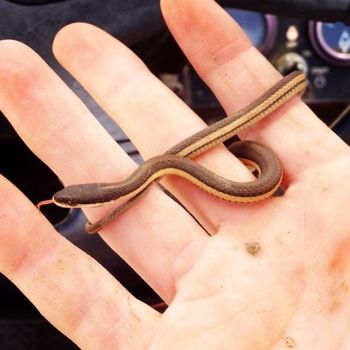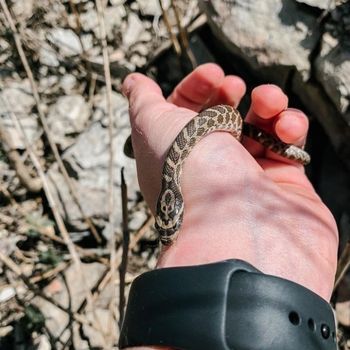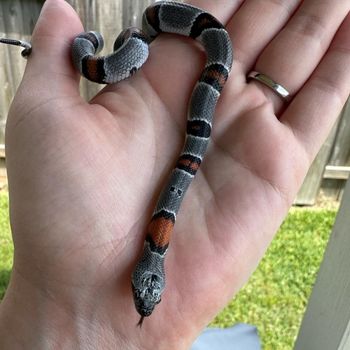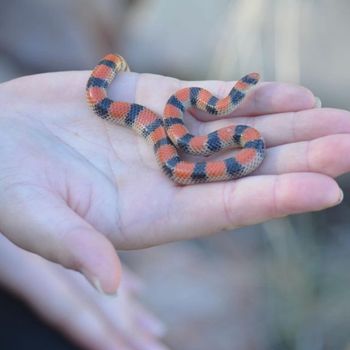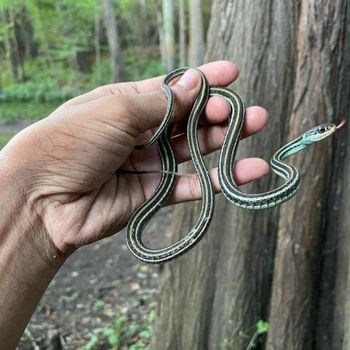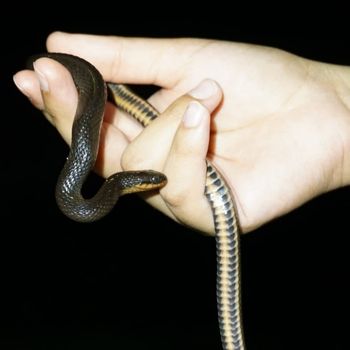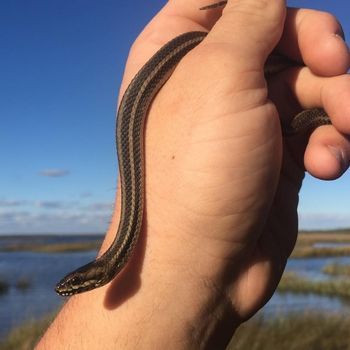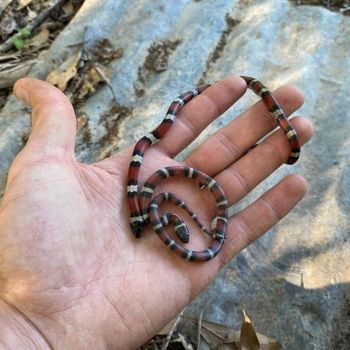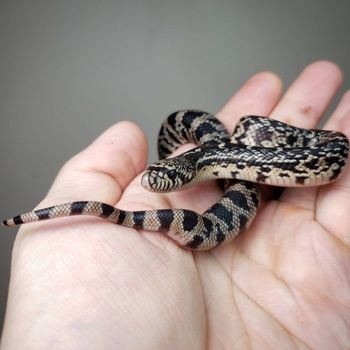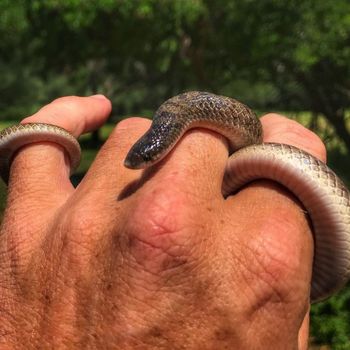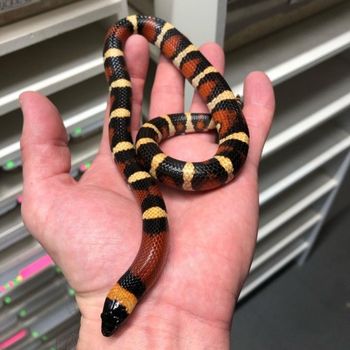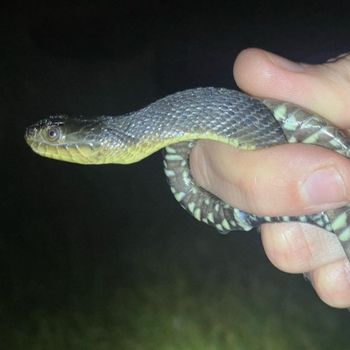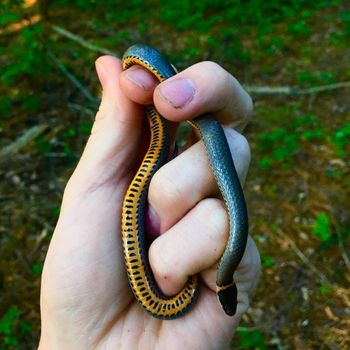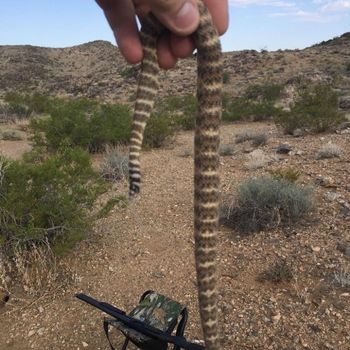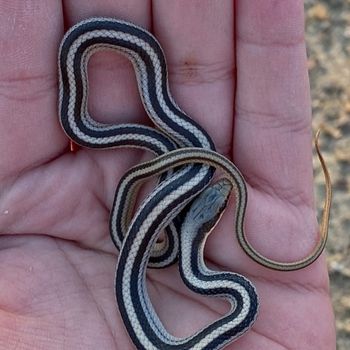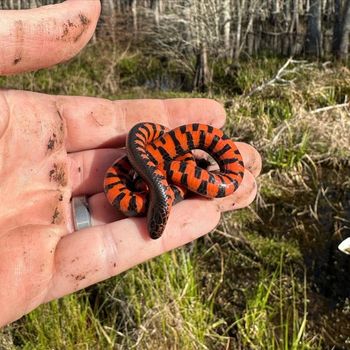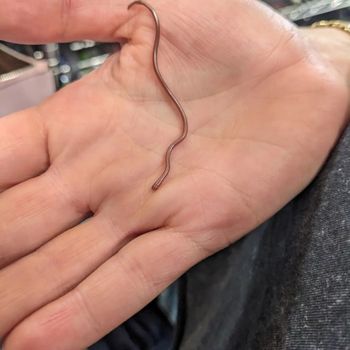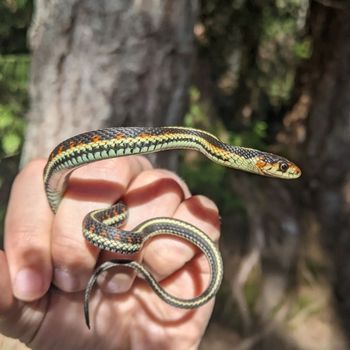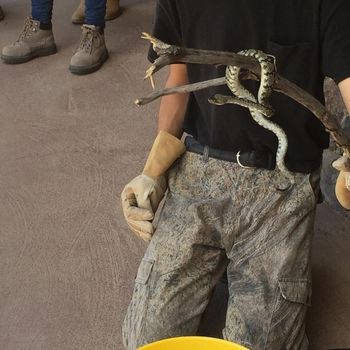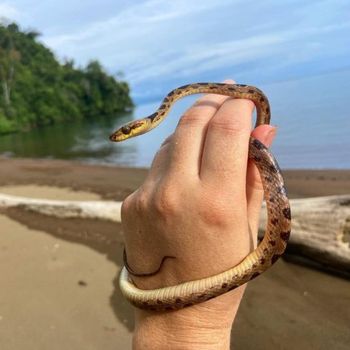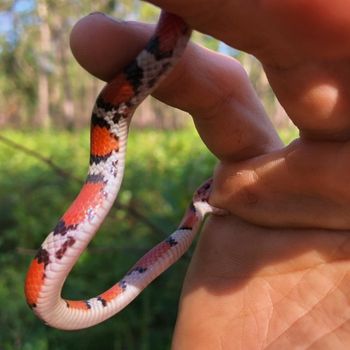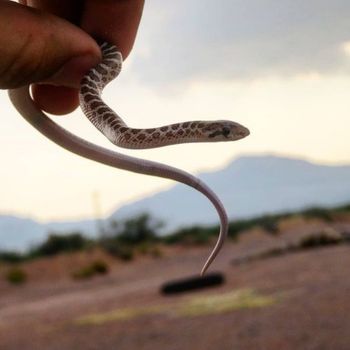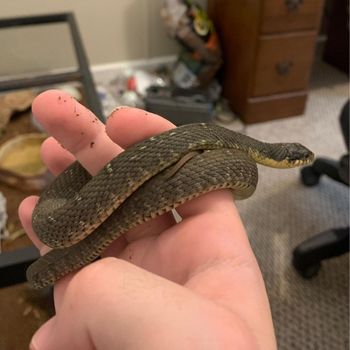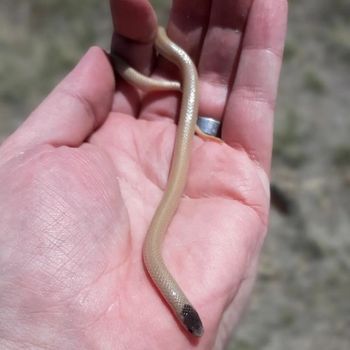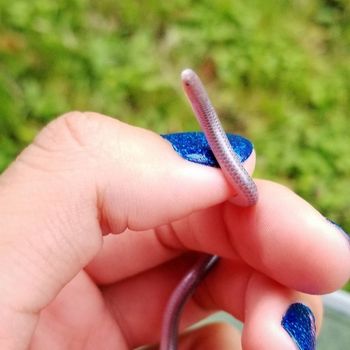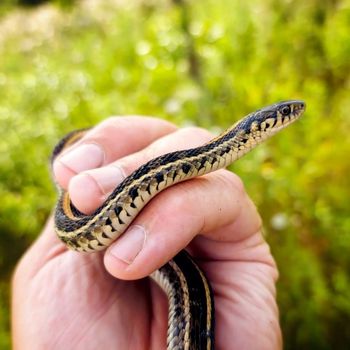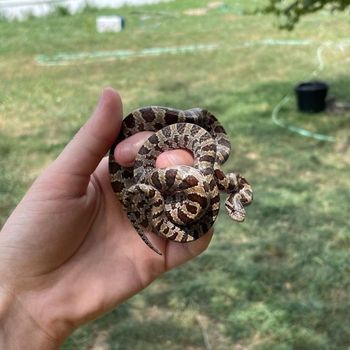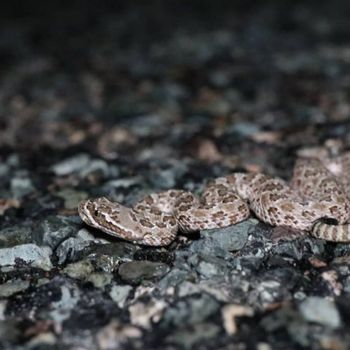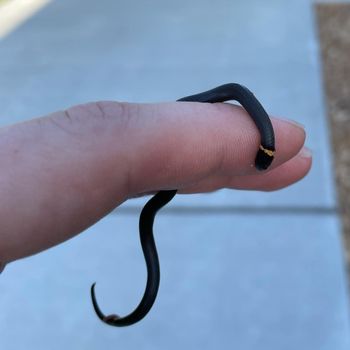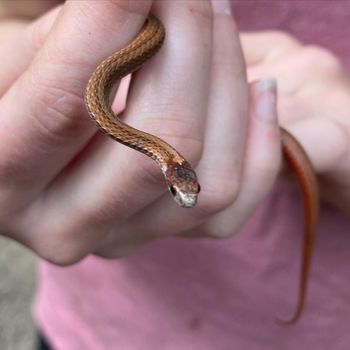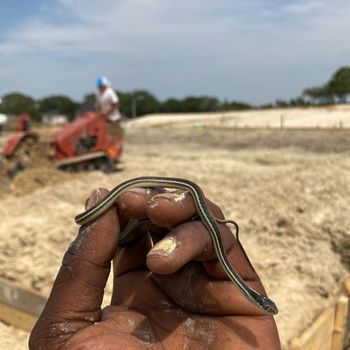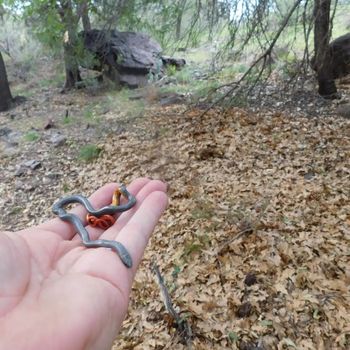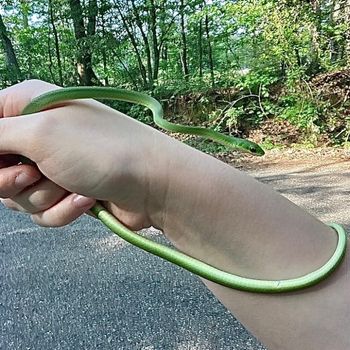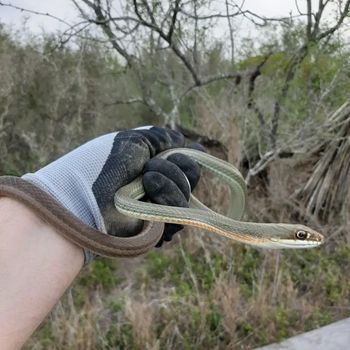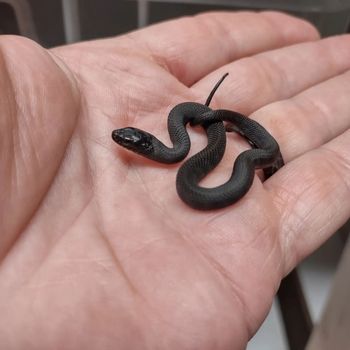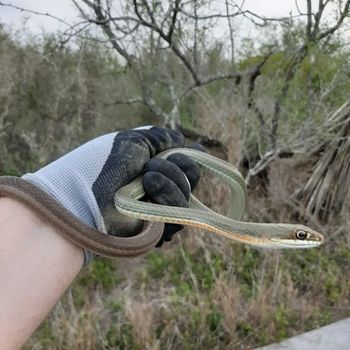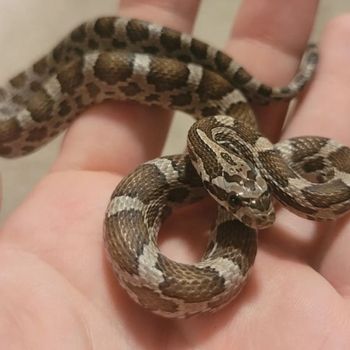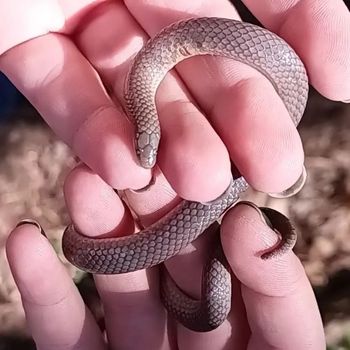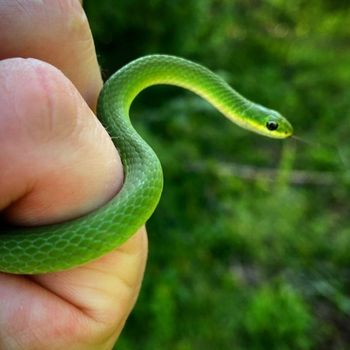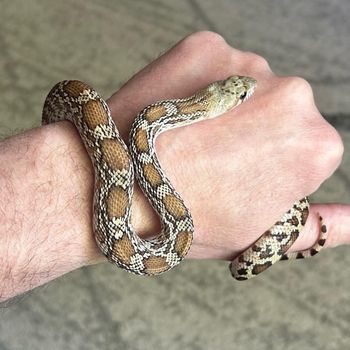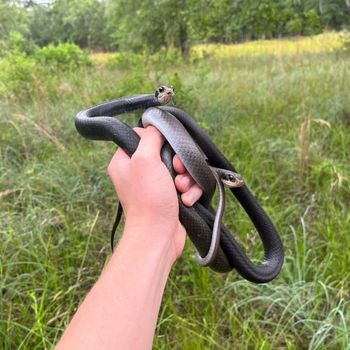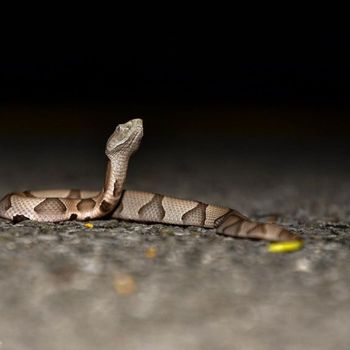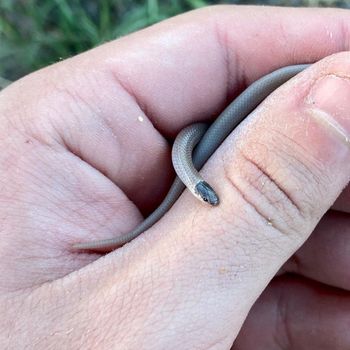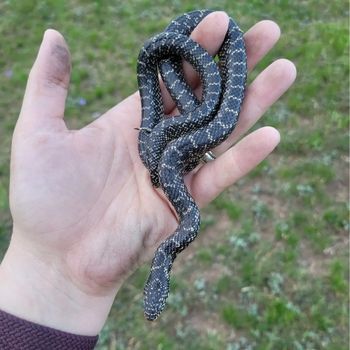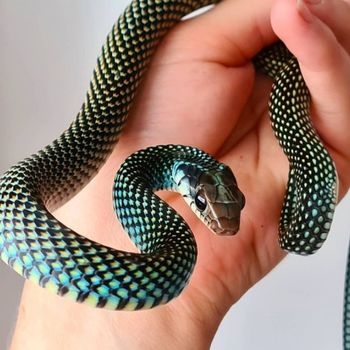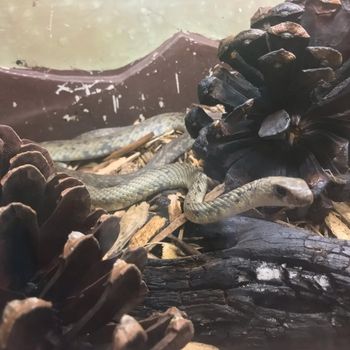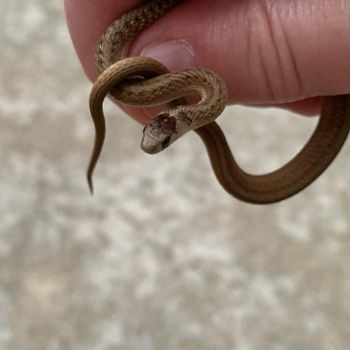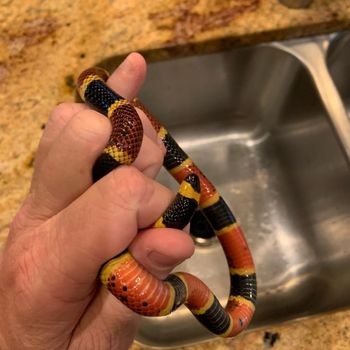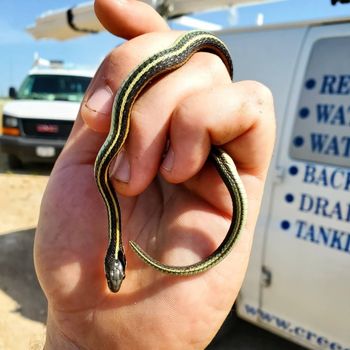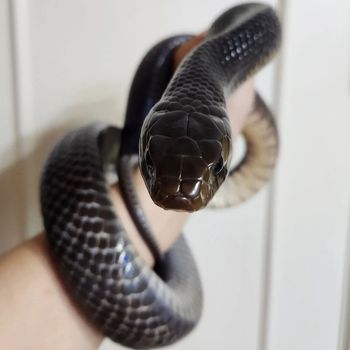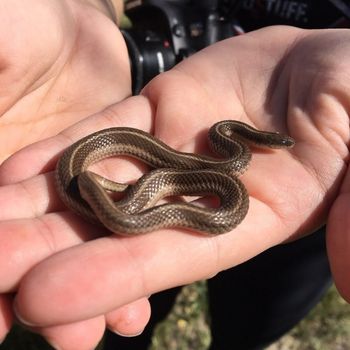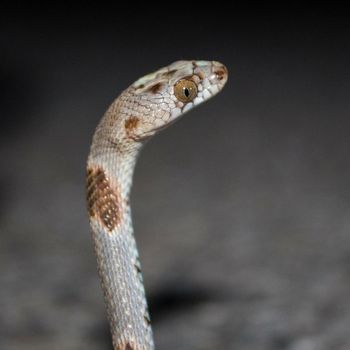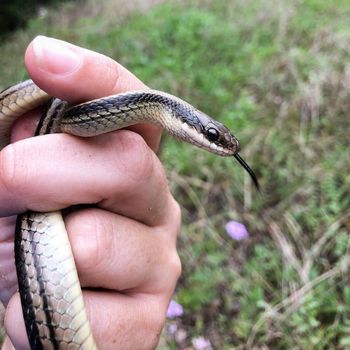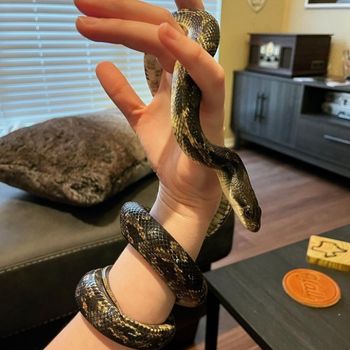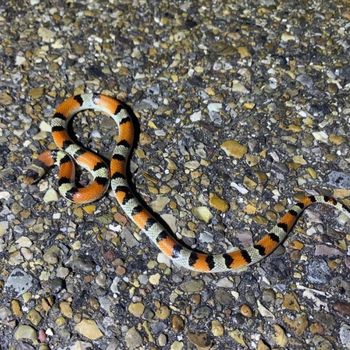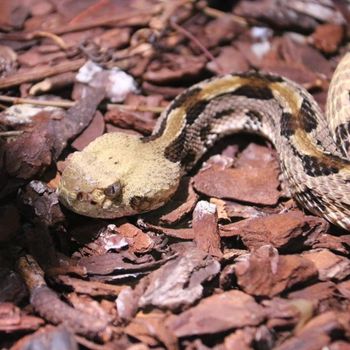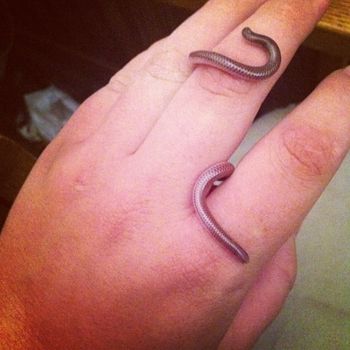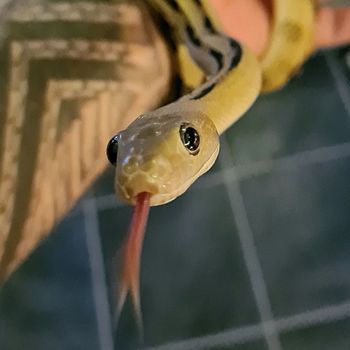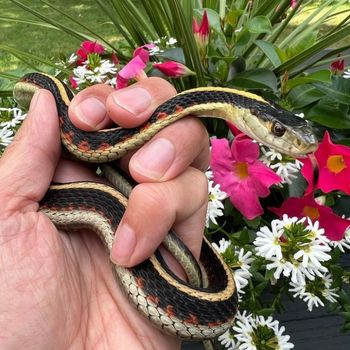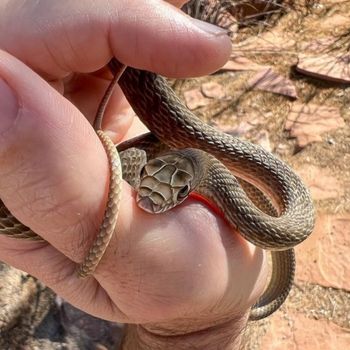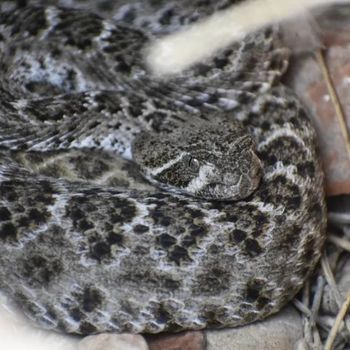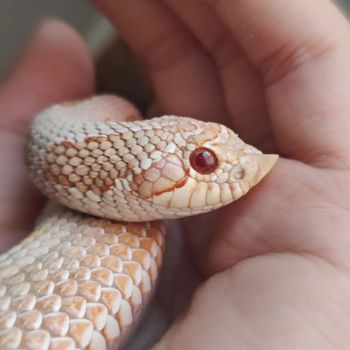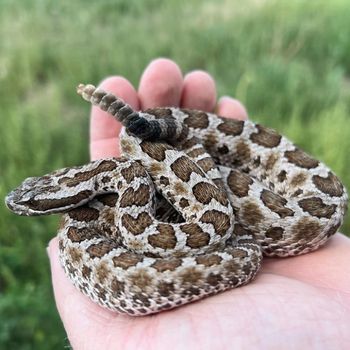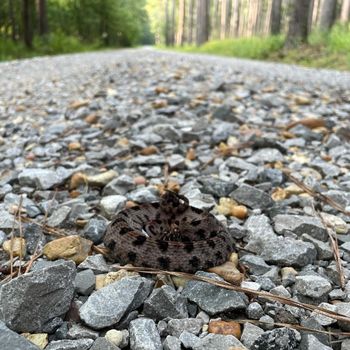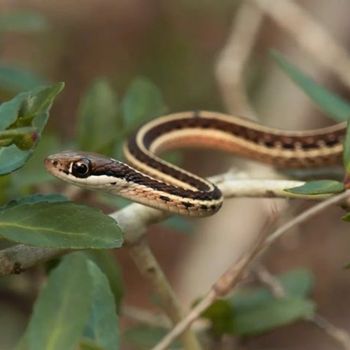Snakes in Texas: Lone Star Grit & Serpents
Howdy, fellow snake enthusiasts! Are y’all ready for an exciting journey through the diverse and fascinating world of Texas snakes? With a whopping 106 species slithering their way through the Lone Star State, you’re in for quite an adventure.
From the tiniest of threadsnakes to the impressively large indigo snake, Texas is a haven for these incredible creatures. And believe it or not, only a small fraction of these species pose any threat to humans.
So, saddle up and get ready to explore the vast variety of serpents that call Texas home. Let’s get started!
| # | Name | Details | Image |
| 1 | Arid Land Ribbon Snake (Thamnophis proximus diabolicus) |
| 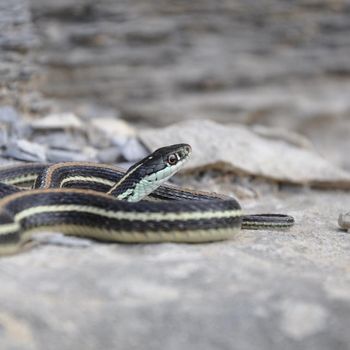 |
| 2 | Baird’s Rat Snake (Pantherophis bairdi) |
|  |
| 3 | Banded Rock Rattlesnake (Crotalus lepidus klauberi) |
| 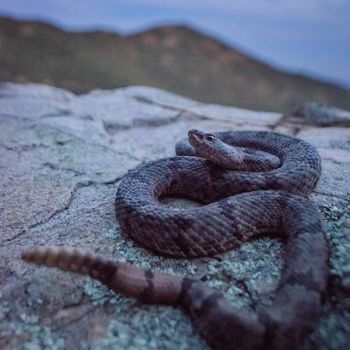 |
| 4 | Big Bend Blackheaded Snake (Tantilla cucullata) |
| 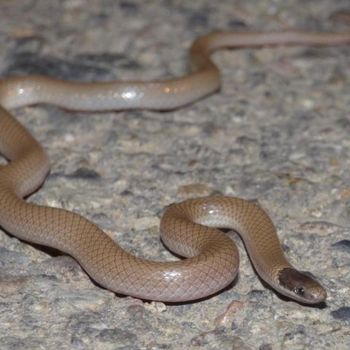 |
| 5 | Big Bend Patchnose Snake (Salvadora deserticola) |
|  |
| 6 | Black Rat Snake (Pantherophis obsoletus) |
| 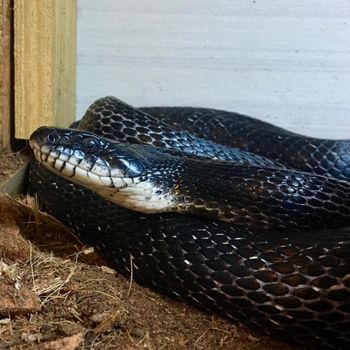 |
| 7 | Black-striped Snake (Coniophanes imperialis) |
| 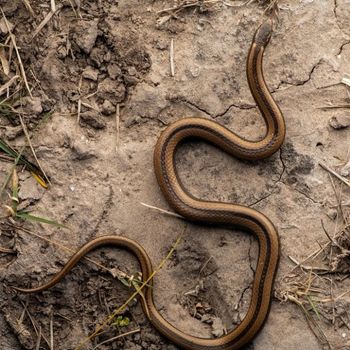 |
| 8 | Blackneck Garter Snake (Thamnophis cyrtopsis) |
| 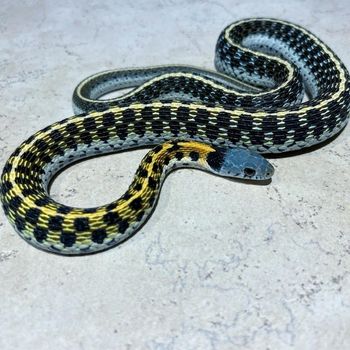 |
| 9 | Blotched Water Snake (Nerodia erythrogaster transversa) |
| 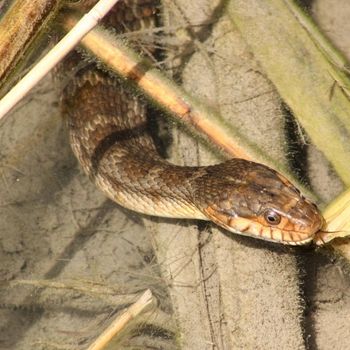 |
| 10 | Brazos Water Snake (Nerodia harteri) |
| 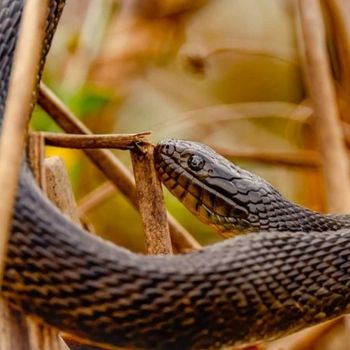 |
| 11 | Broad-banded Copperhead (Agkistrodon contortrix laticinctus) |
| 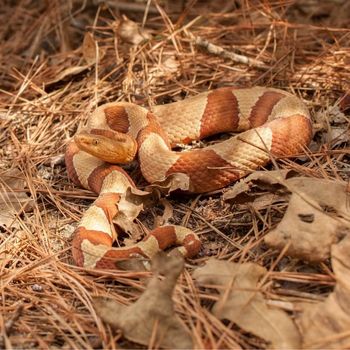 |
| 12 | Broad-banded Water Snake (Nerodia fasciata confluens) |
| 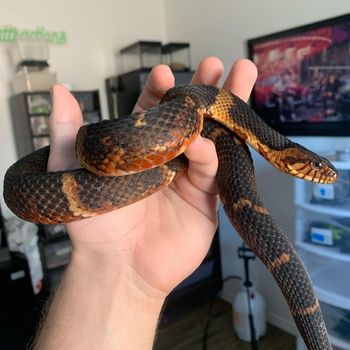 |
| 13 | Bullsnake (Pituophis catenifer sayi) |
| 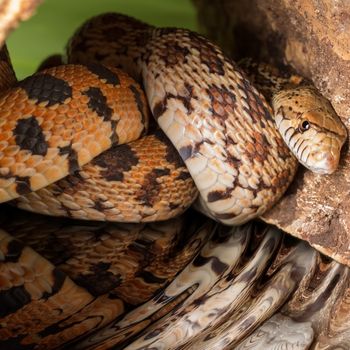 |
| 14 | Buttermilk Racer (Coluber constrictor anthicus) |
| 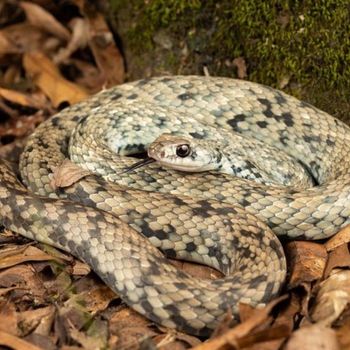 |
| 15 | Central Plains Milksnake (Lampropeltis gentilis) |
| 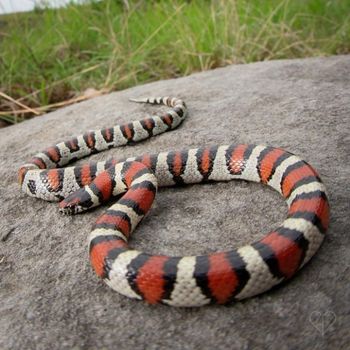 |
| 16 | Central Texas Whipsnake (Masticophis taeniatus) |
| 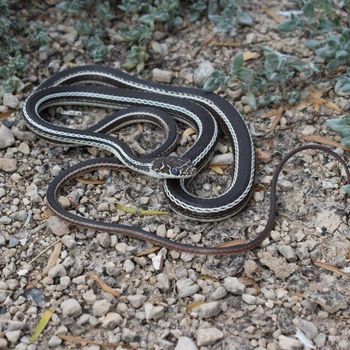 |
| 17 | Checkered Garter Snake (Thamnophis marcianus) |
| 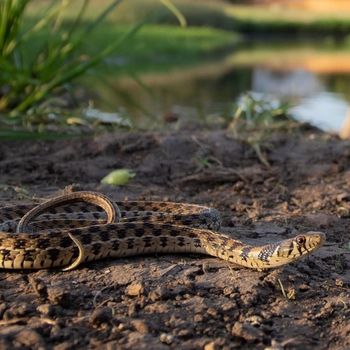 |
| 18 | Concho Water Snake (Nerodia harteri paucimaculata) |
| 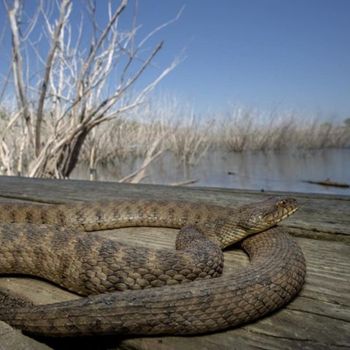 |
| 19 | Corn Snake (Pantherophis guttatus) |
| 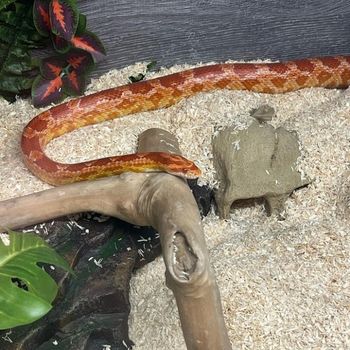 |
| 20 | Cottonmouth (Agkistrodon piscivorus) |
| 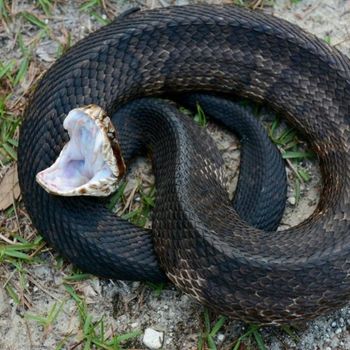 |
| 21 | Dekay’s Brownsnake (Storeria dekayi) |
| 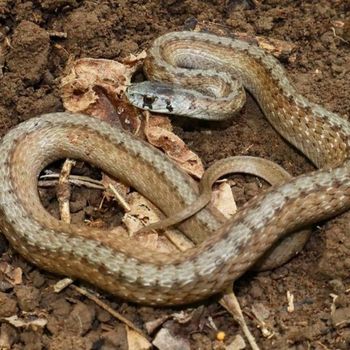 |
| 22 | Desert Kingsnake (Lampropeltis splendida) |
| 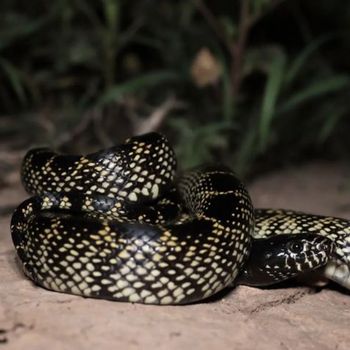 |
| 23 | Desert Massasauga (Sistrurus tergeminus edwardsii) |
| 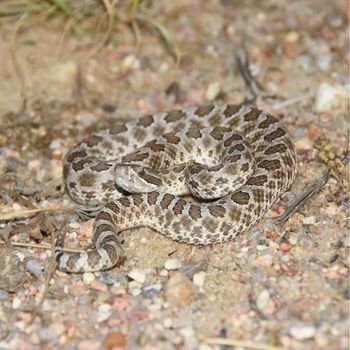 |
| 24 | Desert Striped Whipsnake (Masticophis taeniatus) |
|  |
| 25 | Diamond-backed Water Snake (Nerodia rhombifer) |
| 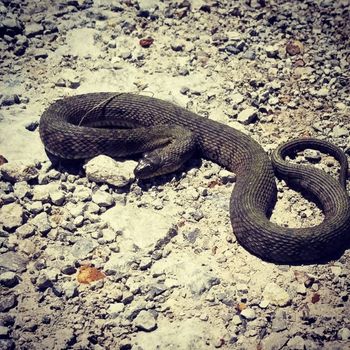 |
| 26 | Dusty Hognose Snake (Heterodon gloydi) |
| 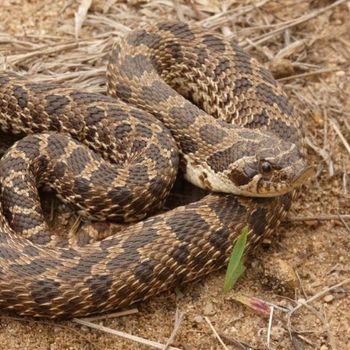 |
| 27 | Eastern coachwhip snake (Masticophis flagellum flagellum) |
|  |
| 28 | Eastern Hog-nosed Snake (Heterodon platirhinos) |
| 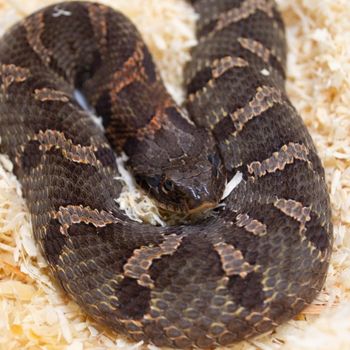 |
| 29 | Eastern Yellow-bellied Racer (Coluber constrictor flaviventris) |
| 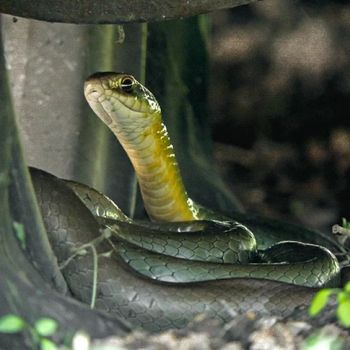 |
| 30 | Flat-headed Snake (Tantilla gracilis) |
| 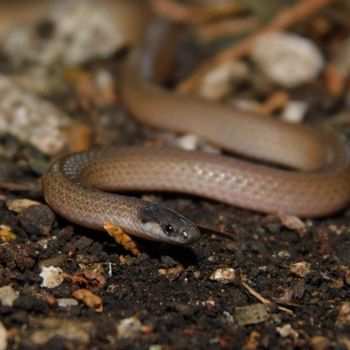 |
| 31 | Florida Water Snake (Nerodia fasciata pictiventris) |
|  |
| 32 | Graham’s Crayfish Snake (Regina grahamii) |
| 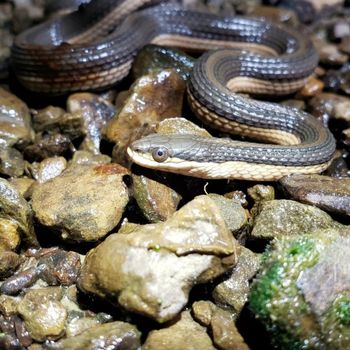 |
| 33 | Great Plains Snake (Pantherophis emoryi) |
| 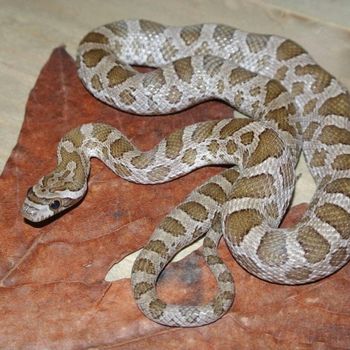 |
| 34 | Grey-banded Kingsnake (Lampropeltis alterna) |
| 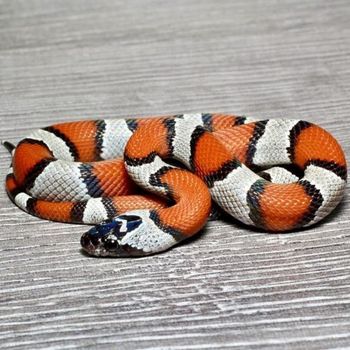 |
| 35 | Ground Snake (Sonora semiannulata) |
| 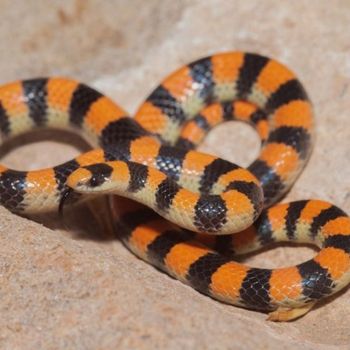 |
| 36 | Gulf Coast Ribbon Snake (Thamnophis proximus orarius) |
| 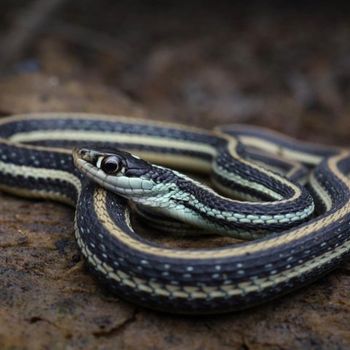 |
| 37 | Gulf Crayfish Snake (Regina rigida sinicola) |
|  |
| 38 | Gulf Salt Marsh Snake (Nerodia clarkii clarkii) |
| 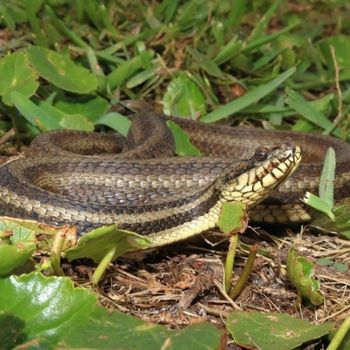 |
| 39 | Kansas Glossy Snake (Arizona elegans elegans) |
|  |
| 40 | Louisiana Milksnake (Lampropeltis triangulum amaura) |
| 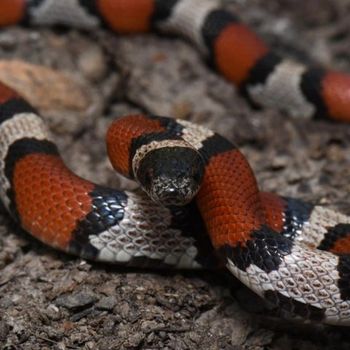 |
| 41 | Louisiana Pine Snake (Pituophis ruthveni) |
| 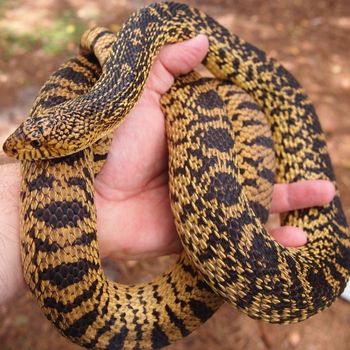 |
| 42 | Mexican Blackhead Snake (Tantilla atriceps) |
| 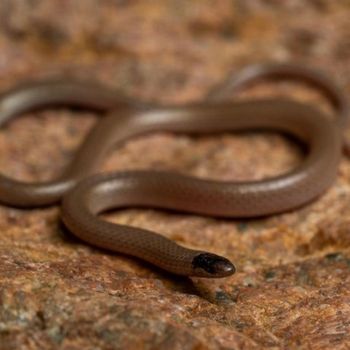 |
| 43 | Mexican Hooknose Snake (Gyalopion canum) |
| 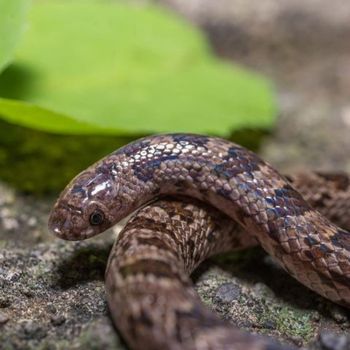 |
| 44 | Mexican Milksnake (Lampropeltis annulata) |
| 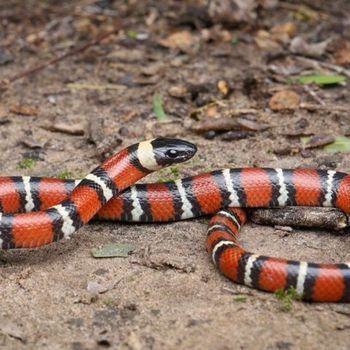 |
| 45 | Mexican Racer (Coluber constrictor oaxaca) |
|  |
| 46 | Mississippi Green Water Snake (Nerodia cyclopion) |
|  |
| 47 | Mississippi Ringneck Snake (Diadophis punctatus stictogenys) |
| 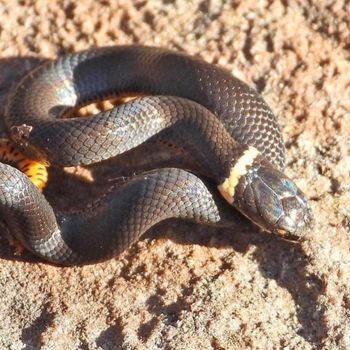 |
| 48 | Mojave Rattlesnake (Crotalus scutulatus) |
| 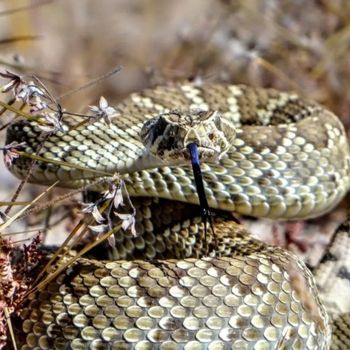 |
| 49 | Mottled Rock Rattlesnake (Crotalus lepidus lepidus) |
| 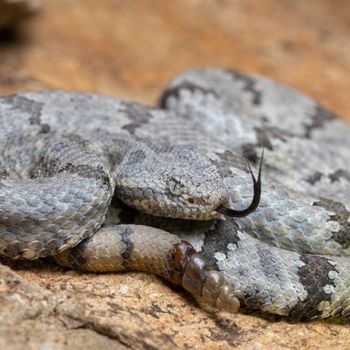 |
| 50 | Mountain Patch Nose Snake (Salvadora grahamiae) |
| 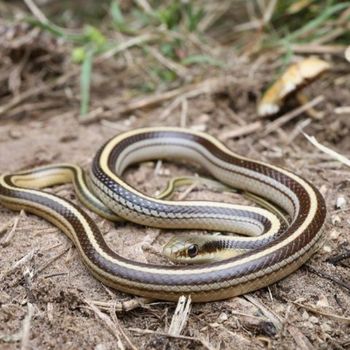 |
| 51 | Mud Snake (Farancia abacura) |
| 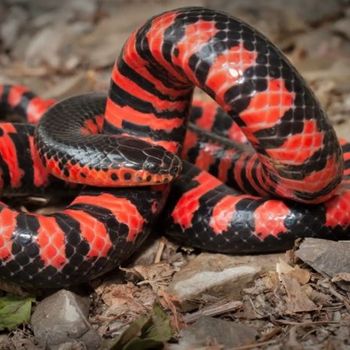 |
| 52 | New Mexico Blind Snake (Rena dissecta) |
| 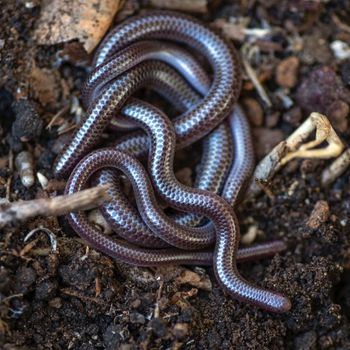 |
| 53 | New Mexico Garter Snake (Thamnophis sirtalis dorsalis) |
| 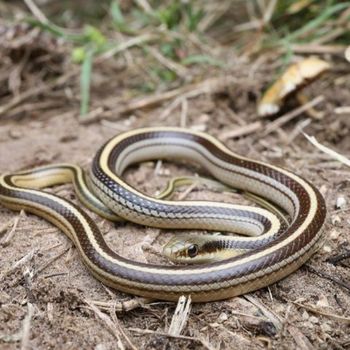 |
| 54 | New Mexico Milksnake (Lampropeltis triangulum celaenops) |
| 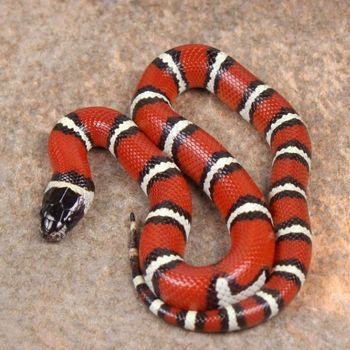 |
| 55 | Northern Blacktail Rattlesnake (Crotalus molossus molossus) |
| 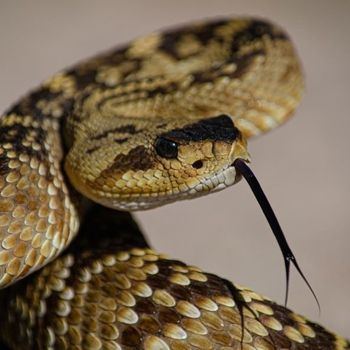 |
| 56 | Northern Cat-eyed Snake (Leptodeira septentrionalis) |
| 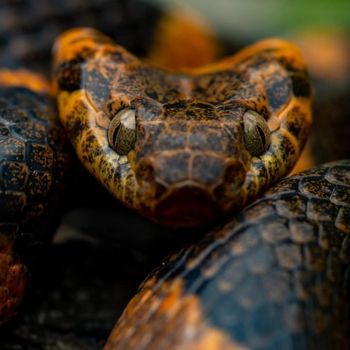 |
| 57 | Northern Scarlet Snake (Cemophora coccinea copei) |
| 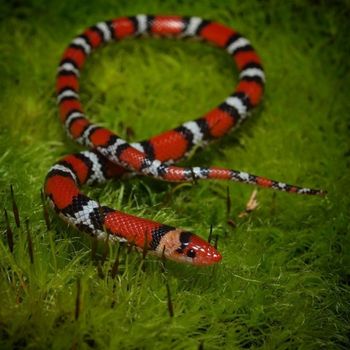 |
| 58 | Painted Desert Glossy Snake (Arizona elegans philipi) |
| 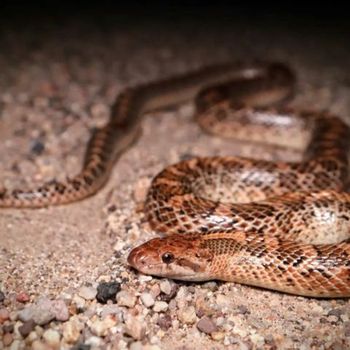 |
| 59 | Plain-bellied Watersnake (Nerodia erythrogaster) |
| 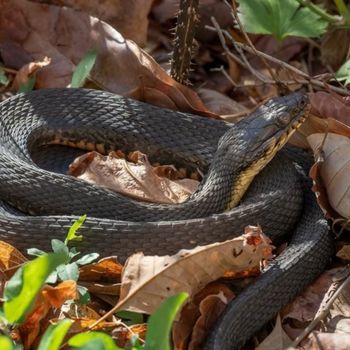 |
| 60 | Plains Black-headed Snake (Tantilla nigriceps) |
| 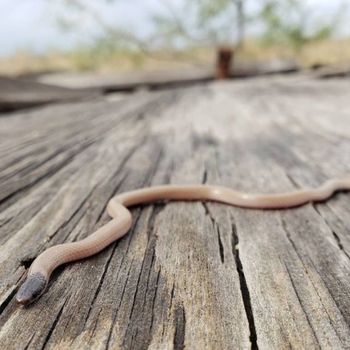 |
| 61 | Plains Blind Snake (Leptotyphlops dulcis) |
| 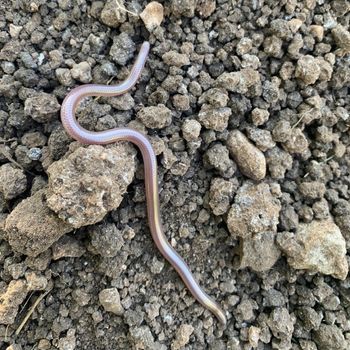 |
| 62 | Plains Garter Snake (Thamnophis radix) |
| 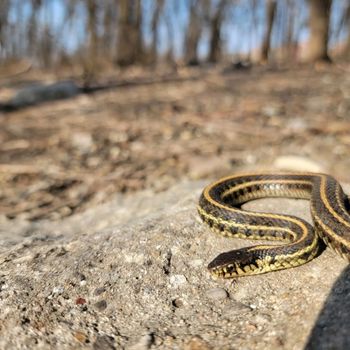 |
| 63 | Prairie Kingsnake (Lampropeltis calligaster) |
|  |
| 64 | Prairie Rattlesnake (Crotalus viridis) |
| 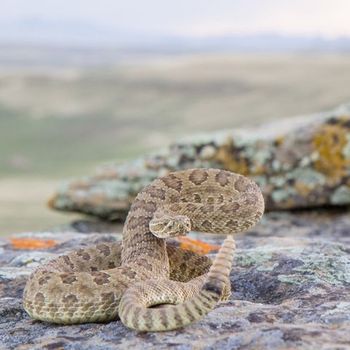 |
| 65 | Prairie Ringneck Snake (Diadophis punctatus arnyi) |
| 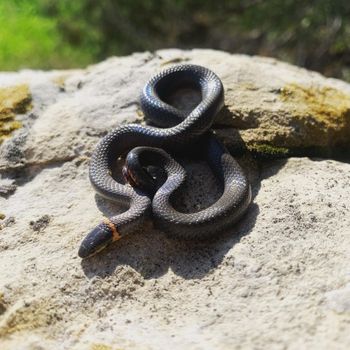 |
| 66 | Red-Bellied Snake (Storeria occipitomaculata) |
|  |
| 67 | Redstripe Ribbon Snake (Thamnophis proximus rubrilineatus) |
| 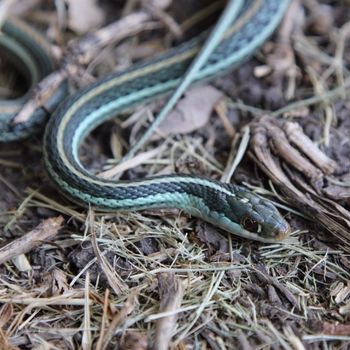 |
| 68 | Regal Ringneck Snake (Diadophis punctatus regalis) |
| 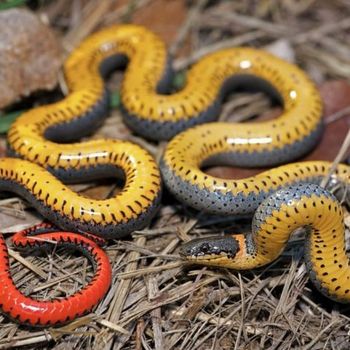 |
| 69 | Rough Green Snake (Opheodrys aestivus) |
| 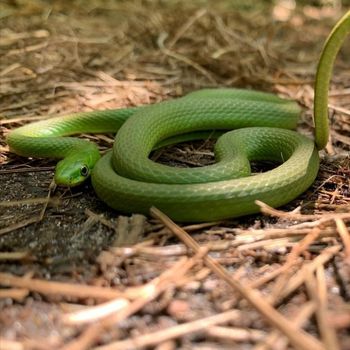 |
| 70 | Ruthven’s Whipsnake (Masticophis ruthveni) |
|  |
| 71 | Salt Marsh Snake (Nerodia clarkii) |
| 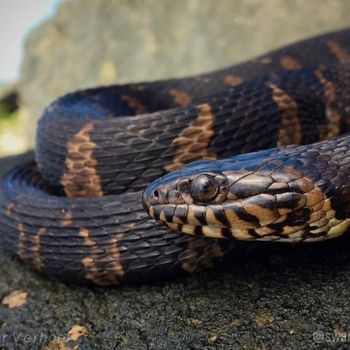 |
| 72 | Schott’s Whipsnake (Masticophis schotti) |
| 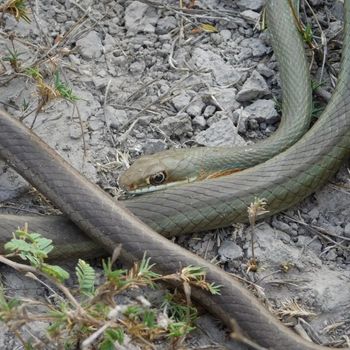 |
| 73 | Slowinski’s Corn Snake (Pantherophis slowinskii) |
| 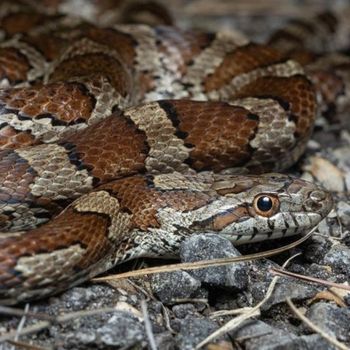 |
| 74 | Smooth Earth Snake (Virginia valeriae) |
| 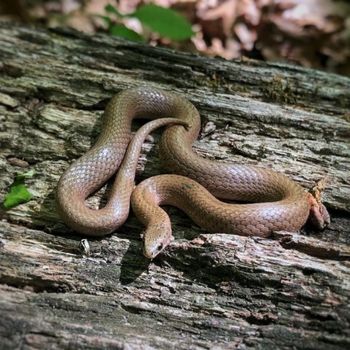 |
| 75 | Smooth Green Snake (Opheodrys vernalis) |
| 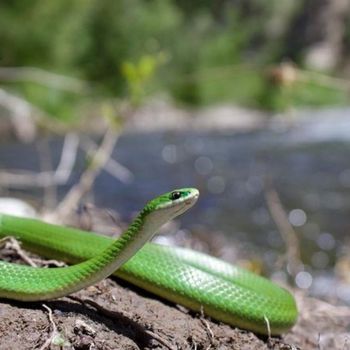 |
| 76 | Sonoran Gophersnake (Pituophis catenifer affinis) |
| 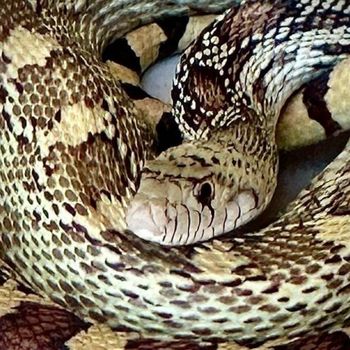 |
| 77 | Southern Black Racer (Coluber constrictor priapus) |
| 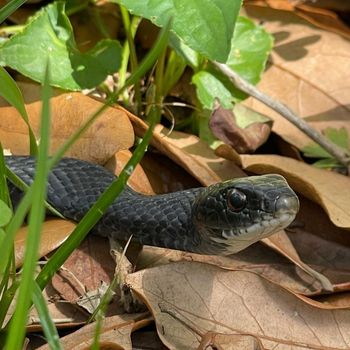 |
| 78 | Southern Copperhead (Agkistrodon contortrix) |
| 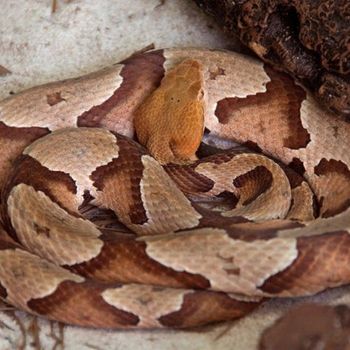 |
| 79 | Southwestern Blackhead Snake (Tantilla hobartsmithi) |
| 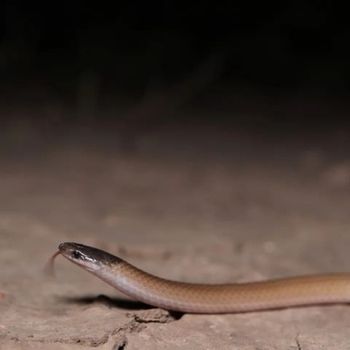 |
| 80 | Speckled Kingsnake (Lampropeltis holbrooki) |
| 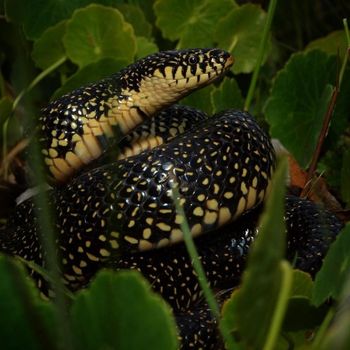 |
| 81 | Speckled Racer (Drymobius margaritiferus) |
| 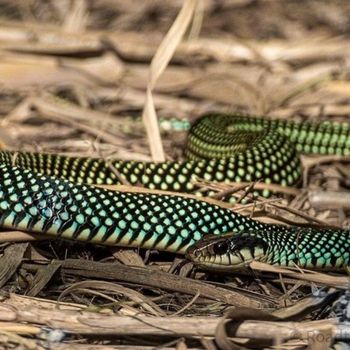 |
| 82 | Tan Racer (Coluber constrictor etheridgei) |
| 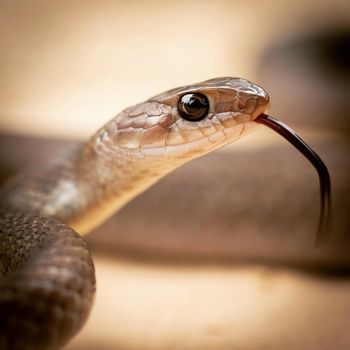 |
| 83 | Texas Brown Snake (Storeria dekayi texana) |
| 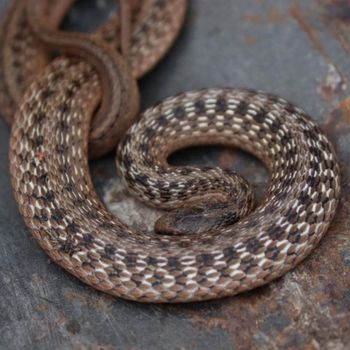 |
| 84 | Texas Coral Snake (Micrurus tener) |
| 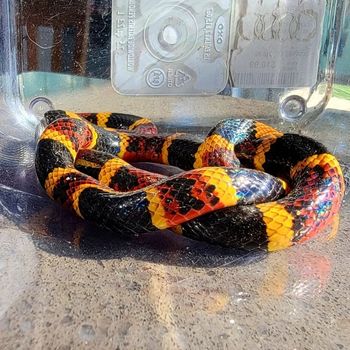 |
| 85 | Texas Garter Snake (Thamnophis sirtalis annectens) |
| 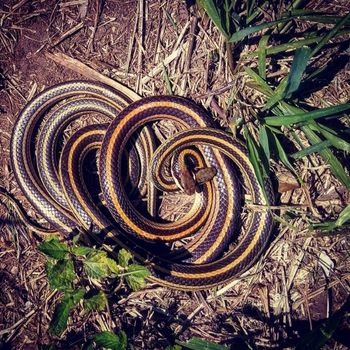 |
| 86 | Texas Glossy Snake (Arizona elegans arenicola) |
| 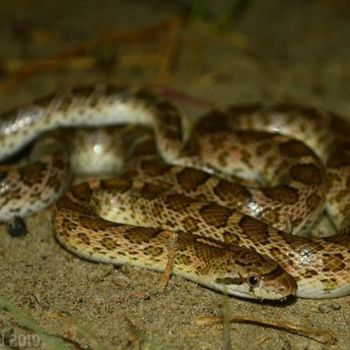 |
| 87 | Texas Indigo Snake (Drymarchon melanurus erebennus) |
| 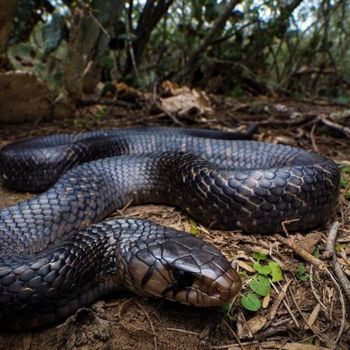 |
| 88 | Texas Lined Snake (Leptotyphlops dulcis) |
| 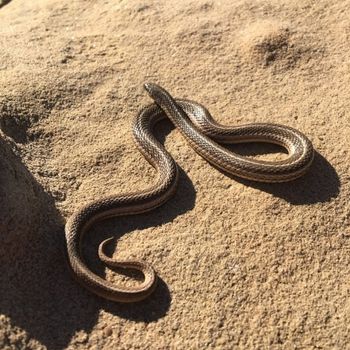 |
| 89 | Texas Longnose Snake (Rhinocheilus lecontei tessellatus) |
| 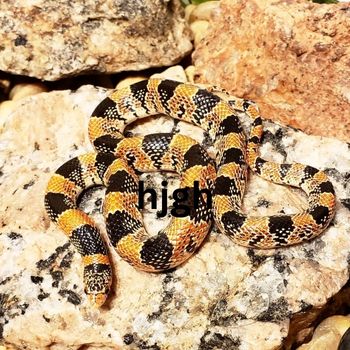 |
| 90 | Texas Lyre Snake (Trimorphodon biscutatus) |
|  |
| 91 | Texas Night Snake (Hypsiglena jani) |
| 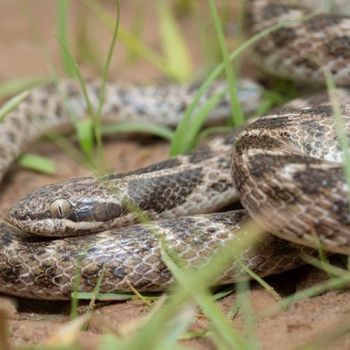 |
| 92 | Texas Patchnose Snake (Salvadora grahamiae lineata) |
|  |
| 93 | Texas Rat Snake (Pantherophis obs- Pantherophis obsoletus) |
| 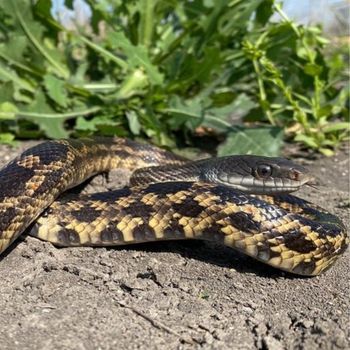 |
| 94 | Texas Scarlet Snake (Cemophora coccinea lineri) |
|  |
| 95 | Timber Rattlesnake (Crotalus horridus) |
|  |
| 96 | Trans-Pecos Blind Snake (Leptotyphlops humilis) |
| 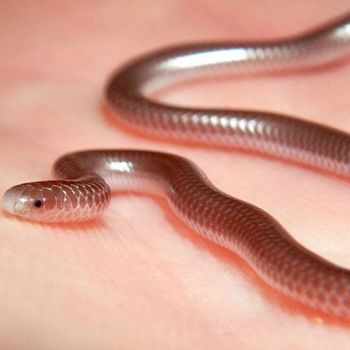 |
| 97 | Trans-Pecos Rat Snake (Bogertophis subocularis) |
| 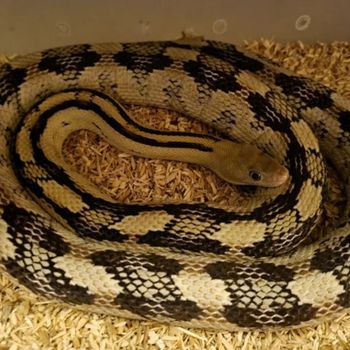 |
| 98 | Valley garter snake (Thamnophis elegans vagrans) |
| 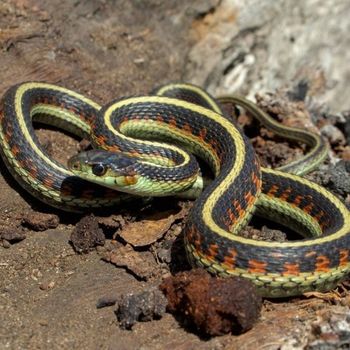 |
| 99 | Western Coachwhip (Masticophis flagellum testaceus) |
| 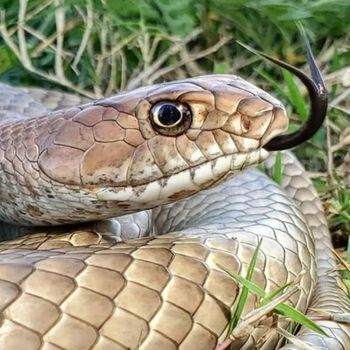 |
| 100 | Western Diamondback Rattlesnake (Crotalus atrox) |
| 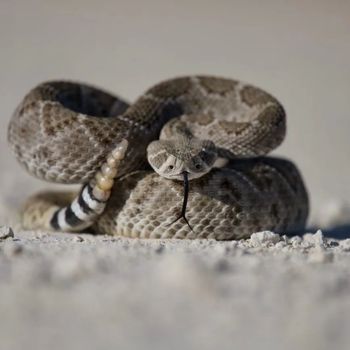 |
| 101 | Western Hognose Snake (Heterodon nasicus) |
| 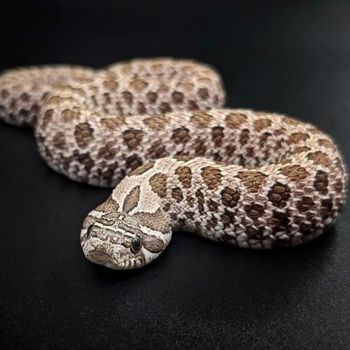 |
| 102 | Western Hooknose Snake (Gyalopion canum) |
| 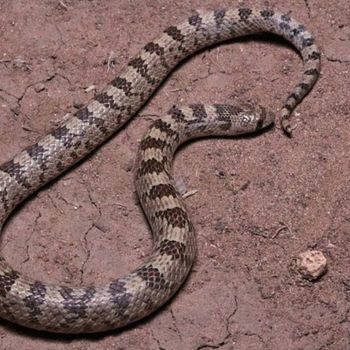 |
| 103 | Western Massasauga (Sistrurus tergeminus) |
| 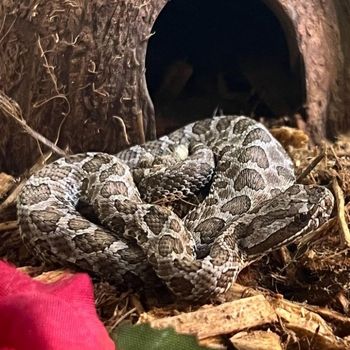 |
| 104 | Western Pygmy Rattlesnake (Sistrurus miliarius streckeri) |
| 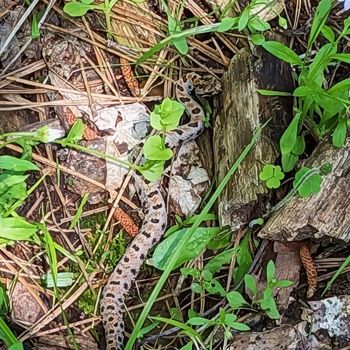 |
| 105 | Western Ribbonsnake (Thamnophis proximus) |
| 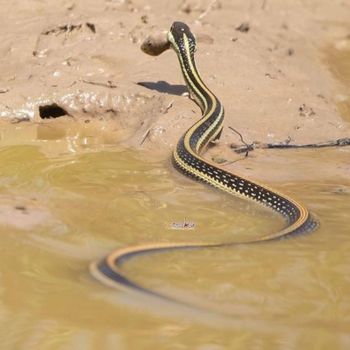 |
| 106 | Western Wormsnake (Carphophis vermis) |
| 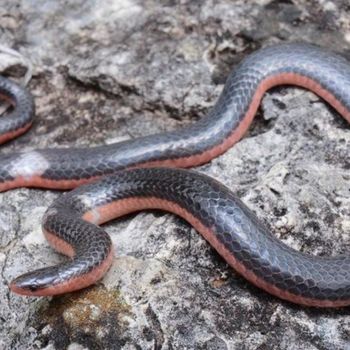 |
106 Snakes You Can Find in Texas
In the state of Texas, a fascinating array of serpents can be found slithering through its diverse landscapes. From venomous to harmless, each species has its unique story to tell. Below, we’ll explore the wonders of these often misunderstood creatures of Texas, from their natural habitats and behaviors to the challenges they face in our changing world.
1. Arid Land Ribbon Snake
- Scientific Name: Thamnophis proximus diabolicus
- Common Name: Arid land ribbon snake
- Size: Up to 30 inches (76 cm)
- Natural Habitat: Arid and semi-arid habitats, near water sources
- Color: Olive-green or brown with yellowish stripes
- Habitat: Arid and semi-arid habitats, near water sources
- Maximum Size: Up to 30 inches (76 cm)
- Diet: Amphibians, small fish, and invertebrates
- Reproduction: Live-bearing, 3-26 offspring per litter
- Venom: Non-venomous
- Conservation: Least concern
The Arid Land Ribbon Snake (Thamnophis proximus diabolicus) is a non-venomous snake that grows up to 30 inches (76 cm) long. It has an olive-green or brown coloration, adorned with yellowish stripes. Inhabitants of arid and semi-arid regions, these snakes reside near water sources due to their semi-aquatic and diurnal nature. Their diet consists mainly of amphibians, small fish, and invertebrates that roams in the state of Texas. The Arid Land Ribbon Snake is a live-bearing species, producing 3-26 offspring per litter. It is currently classified as “Least Concern” in conservation status.
2. Baird’s Rat Snake
- Scientific Name: Pantherophis bairdi
- Common Name: Baird’s rat snake
- Size: Up to 6 feet (1.8 meters)
- Natural Habitat: Dry, rocky habitats, including hillsides and canyons
- Color: Gray, tan or brown with dark blotches
- Habitat: Dry, rocky habitats, including hillsides and canyons
- Maximum Size: Up to 6 feet (1.8 meters)
- Diet: Rodents, birds, and eggs
- Reproduction: Lay eggs in clutches of 5-15
- Venom: Non-venomous
- Conservation: Least concern
Pantherophis bairdi, commonly known as Baird’s Rat Snake, is a non-venomous reptile that can grow up to 6 feet (1.8 meters) in length. With colors ranging from gray, tan, or brown and featuring dark blotches, these snakes of Texas inhabit dry, rocky habitats like hillsides and canyons. They are nocturnal and terrestrial predators, feeding on rodents, birds, and eggs. Females lay eggs in clutches of 5-15, and the species has a conservation status of “Least Concern.”
3. Banded Rock Rattlesnake
- Scientific Name: Crotalus lepidus klauberi
- Common Name: Banded rock rattlesnake
- Size: 16-33 inches (40-84 cm)
- Natural Habitat: Rocky habitats, including canyons, cliffs, and slopes
- Color: Gray or blue-gray with dark bands
- Habitat: Rocky habitats, including canyons, cliffs, and slopes
- Maximum Size: 16-33 inches (40-84 cm)
- Diet: Small mammals, lizards, and birds
- Reproduction: Viviparous, 2-8 offspring per litter
- Venom: Venomous, but not considered highly dangerous to humans
- Conservation: Least concern
The Banded Rock Rattlesnake (Crotalus lepidus klauberi) is a venomous snake of Texas measuring 16-33 inches (40-84 cm) in length. These nocturnal reptiles exhibit a gray or blue-gray color with distinct dark bands on their scales. They inhabit rocky terrains such as canyons, cliffs, and slopes, feeding primarily on small mammals, lizards, and birds. As viviparous snakes, they give live birth to 2-8 offspring per litter. Though venomous, their bites are not highly dangerous to humans, and their conservation status is listed as Least Concern.
4. Big Bend Blackheaded Snake
- Scientific Name: Tantilla cucullata
- Common Name: Big bend blackheaded snake
- Size: 6-10 inches (15-25 cm)
- Natural Habitat: Desert scrublands, grasslands, and rocky areas
- Color: Black head, gray or brown body with a light-colored stripe on the neck
- Habitat: Desert scrublands, grasslands, and rocky areas
- Maximum Size: 6-10 inches (15-25 cm)
- Diet: Centipedes, spiders, and insects
- Reproduction: Lay eggs in clutches of 1-3
- Venom: Non-venomous
- Conservation: Least concern
The Big Bend Blackheaded Snake (Tantilla cucullata) is a small, non-venomous reptile, measuring 6-10 inches (15-25 cm) in length. It is characterized by its distinct black head, gray or brown body, and light-colored stripe on the neck. Primarily nocturnal and fossorial, this snake inhabits desert scrublands, grasslands, and rocky areas of Texas. Its diet consists of centipedes, spiders, and insects. Females lay eggs in clutches of 1-3. The species is listed as Least Concern in conservation status.
5. Big Bend Patchnose Snake
- Scientific Name: Salvadora deserticola
- Common Name: Big bend patchnose snake
- Size: 20-45 inches (51-114 cm)
- Natural Habitat: Desert scrublands, rocky areas, and grasslands
- Color: Gray or brown with a light-colored dorsal stripe
- Habitat: Desert scrublands, rocky areas, and grasslands
- Maximum Size: 20-45 inches (51-114 cm)
- Diet: Lizards, small mammals, and birds
- Reproduction: Lay eggs in clutches of 3-10
- Venom: Non-venomous
- Conservation: Least concern
The Big Bend Patchnose Snake (Salvadora deserticola) is a non-venomous reptile, measuring 20-45 inches (51-114 cm) in length. This snake of Texas has a gray or brown coloration with a light-colored dorsal stripe, giving it effective camouflage in its desert scrubland, rocky and grassland habitats. As a diurnal and terrestrial creature, its diet mainly consists of lizards, small mammals, and birds. Reproducing by laying egg clutches of 3-10, this species has a conservation status of Least Concern.
6. Black Rat Snake
- Scientific Name: Pantherophis obsoletus
- Common Name: Black rat snake
- Size: Up to 8 feet (2.4 meters)
- Natural Habitat: Forests, grasslands, and urban areas
- Color: Black with faint dark blotches
- Habitat: Forests, grasslands, and urban areas
- Maximum Size: Up to 8 feet (2.4 meters)
- Diet: Rodents, birds, and eggs
- Reproduction: Lay eggs in clutches of 5-30
- Venom: Non-venomous
- Conservation: Least concern
Pantherophis obsoletus, commonly known as Black Rat Snake, can grow up to 8 feet (2.4 meters) long, with a black and dark-blotched coloring. These non-venomous reptiles inhabit forests, grasslands, and urban areas of Texas, showcasing diurnal and semi-arboreal behavior. Their diet consists of rodents, birds, and eggs. Female Black Rat Snakes lay eggs in clutches of 5-30 during the reproduction season. Although not endangered, these snakes play an important role in controlling rodent populations.
7. Black-striped Snake
- Scientific Name: Coniophanes imperialis
- Common Name: Black-striped snake
- Size: 12-28 inches (30-71 cm)
- Natural Habitat: Forests, grasslands, and scrublands
- Color: Gray or brown with a black stripe
- Habitat: Forests, grasslands, and scrublands
- Maximum Size: 12-28 inches (30-71 cm)
- Diet: Lizards, amphibians, and small mammals
- Reproduction: Lay eggs in clutches of 2-4
- Venom: Mildly venomous, rear-fanged (not dangerous to humans)
- Conservation: Least concern
The Black-striped Snake (Coniophanes imperialis) is a small nocturnal reptile measuring 12-28 inches (30-71 cm) in length, with a gray or brown coloration and a distinctive black stripe. It inhabits forests, grasslands, and scrublands, spending most of its time on the ground. It feeds on lizards, amphibians, and small mammals. Females lay egg clutches, usually containing 2-4 eggs. Though mildly venomous, with rear fangs, it poses no significant threat to humans. Its conservation status is listed as ‘Least Concern.’
8. Blackneck Garter Snake
- Scientific Name: Thamnophis cyrtopsis
- Common Name: Blackneck garter snake
- Size: 16-42 inches (40-107 cm)
- Natural Habitat: Near water sources, including streams, rivers, and ponds
- Color: Olive-green or brown with dark stripes and a black neck
- Habitat: Near water sources, including streams, rivers, and ponds
- Maximum Size: 16-42 inches (40-107 cm)
- Diet: Amphibians, fish, and invertebrates
- Reproduction: Live-bearing, 10-40 offspring per litter
- Venom: Mildly venomous, rear-fanged (not dangerous to humans)
- Conservation: Least concern
The Blackneck Garter Snake (Thamnophis cyrtopsis) is a mildly venomous, diurnal, and semi-aquatic reptile measuring between 16-42 inches in length. Its olive-green or brown coloring features dark stripes and a distinctive black neck. Commonly found near water sources such as streams, rivers, and ponds of Texas, it primarily feeds on amphibians, fish, and invertebrates. As a live-bearing species, it produces 10-40 offspring per litter. Although rear-fanged, its venom is not dangerous to humans. Its conservation status is currently classified as Least Concern.
9. Blotched Water Snake
- Scientific Name: Nerodia erythrogaster transversa
- Common Name: Blotched water snake
- Size: 24-42 inches (61-107 cm)
- Natural Habitat: Near water sources, including lakes, rivers, and ponds
- Color: Brown or gray with dark blotches
- Habitat: Near water sources, including lakes, rivers, and ponds
- Maximum Size: 24-42 inches (61-107 cm)
- Diet: Fish, amphibians, and invertebrates
- Reproduction: Live-bearing, 8-57 offspring per litter
- Venom: Non-venomous
- Conservation: Least concern
The Blotched Water Snake (Nerodia erythrogaster transversa) is a semi-aquatic, nocturnal reptile measuring 24-42 inches in length. Its brown or gray skin features dark blotches, and it thrives near various water sources such as lakes, ponds, and rivers. This non-venomous snake has a diverse diet, consisting mainly of fish, amphibians, and invertebrates. It reproduces through live-bearing and can give birth to 8-57 offspring per litter. Currently, the Blotched Water Snake holds a conservation status of Least Concern.
10. Brazos Water Snake
- Scientific Name: Nerodia harteri
- Common Name: Brazos water snake
- Size: 16-32 inches (40-81 cm)
- Natural Habitat: Near water sources, mainly in the brazos river system
- Color: Brown or gray with dark bands
- Habitat: Near water sources, mainly in the brazos river system
- Maximum Size: 16-32 inches (40-81 cm)
- Diet: Fish, amphibians, and invertebrates
- Reproduction: Live-bearing, 7-29 offspring per litter
- Venom: Non-venomous
- Conservation: Least concern
The Brazos Water Snake (Nerodia harteri) is a non-venomous, brown or gray reptile that grows between 16-32 inches in length. Recognizable by its dark bands, this nocturnal, semi-aquatic snake inhabits the Brazos River system, where it preys on fish, amphibians, and invertebrates. Nerodia harteri is a live-bearing species, capable of producing 7-29 offspring per litter. Despite being a relatively common species in Texas, it is rated as “Least Concern” in terms of conservation.
11. Broad-banded Copperhead
- Scientific Name: Agkistrodon contortrix laticinctus
- Common Name: Broad-banded copperhead
- Size: 20-36 inches (51-91 cm)
- Natural Habitat: Forests, grasslands, and rocky terrains
- Color: Coppery-brown with dark bands
- Habitat: Forests, grasslands, and rocky terrains
- Maximum Size: 20-36 inches (51-91 cm)
- Diet: Rodents, birds, and amphibians
- Reproduction: Viviparous, 3-10 offspring per litter
- Venom: Venomous (hemotoxic)
- Conservation: Least concern
The Broad-banded Copperhead (Agkistrodon contortrix laticinctus) is a venomous snake, measuring 20-36 inches (51-91 cm) in length. It exhibits a coppery-brown color with dark bands, and inhabits forests, grasslands, and rocky terrains. As a nocturnal and terrestrial species, its diet primarily consists of rodents, birds, and amphibians. The snake is viviparous, giving birth to 3-10 offspring per litter. Its venom is hemotoxic, and despite its potential danger to humans, it has a conservation status of Least Concern.
12. Broad-banded Water Snake
- Scientific Name: Nerodia fasciata confluens
- Common Name: Broad-banded water snake
- Size: 24-42 inches (61-106 cm)
- Natural Habitat: Aquatic habitats, including lakes, ponds, streams, and swamps
- Color: Brown or gray with dark bands
- Habitat: Aquatic habitats, including lakes, ponds, streams, and swamps
- Maximum Size: 24-42 inches (61-106 cm)
- Diet: Fish and amphibians
- Reproduction: Viviparous, 8-58 offspring per litter
- Venom: Non-venomous
- Conservation: Least concern
The Broad-banded Water Snake (Nerodia fasciata confluens) is a non-venomous aquatic snake inhabiting lakes, ponds, streams, and swamps. Measuring 24-42 inches (61-106 cm) in length, its color ranges from brown to gray with dark bands. Being diurnal and semi-aquatic, its diet consists of fish and amphibians. This viviparous species has 8-58 offspring per litter with a conservation status of Least Concern.
13. Bullsnake
- Scientific Name: Pituophis catenifer sayi
- Common Name: Bull snake
- Size: 4-6 feet (1.2-1.8 meters)
- Natural Habitat: Grasslands, deserts, woodlands, and agricultural areas
- Color: Brown or yellowish with dark blotches
- Habitat: Grasslands, deserts, woodlands, and agricultural areas
- Maximum Size: 4-6 feet (1.2-1.8 meters)
- Diet: Rodents, rabbits, ground-nesting birds, and eggs
- Reproduction: Lay eggs in clutches of 5-22
- Venom: Non-venomous
- Conservation: Least concern
The Bullsnake (Pituophis catenifer sayi), a non-venomous constrictor, measures 4-6 feet (1.2-1.8 meters) and exhibits a brown or yellowish color with dark blotches. Found in grasslands, deserts, woodlands, and agricultural areas, these diurnal and terrestrial snakes primarily feed on rodents, rabbits, ground-nesting birds, and eggs. During the reproduction, the female Bullsnake lays egg clutches ranging from 5-22. With a conservation status listed as “Least Concern”, the Bullsnake is not currently under threat in Texas.
14. Buttermilk Racer
- Scientific Name: Coluber constrictor anthicus
- Common Name: Buttermilk racer
- Size: 20-65 inches (51-165 cm)
- Natural Habitat: Woodlands, prairies, and grasslands
- Color: Gray or brown with cream-colored speckles
- Habitat: Woodlands, prairies, and grasslands
- Maximum Size: 20-65 inches (51-165 cm)
- Diet: Rodents, birds, lizards, frogs, and insects
- Reproduction: Lay eggs in clutches of 3-12
- Venom: Non-venomous
- Conservation: Least concern
The Buttermilk Racer (Coluber constrictor anthicus) is a non-venomous snake species that ranges in size from 20-65 inches (51-165 cm) and features a gray or brown color with cream-colored speckles. Found inhabiting woodlands, prairies, and grasslands of Texas, this diurnal and terrestrial snake preys on rodents, birds, lizards, frogs, and insects. It reproduces by laying eggs in clutches of 3-12. Listed as a species of Least Concern, Buttermilk Racers remain relatively common within their preferred habitats.
15. Central Plains Milksnake
- Scientific Name: Lampropeltis gentilis
- Common Name: Central plains milksnake
- Size: 16-32 inches (40-81 cm)
- Natural Habitat: Prairies, woodlands, and rocky hillsides
- Color: Reddish-brown with alternating light and dark bands
- Habitat: Prairies, woodlands, and rocky hillsides
- Maximum Size: 16-32 inches (40-81 cm)
- Diet: Small mammals, birds, reptiles, and amphibians
- Reproduction: Lay eggs in clutches of 3-13
- Venom: Non-venomous
- Conservation: Least concern
Its scientific name is Lampropeltis gentilis. These cool creatures are between 16-32 inches long and have a stunning reddish-brown color with alternating light and dark bands. They love hanging out in prairies, woodlands, and rocky hillsides. As night owls, they’re nocturnal and terrestrial. They snack on small mammals, birds, reptiles, and amphibians. When it comes to family, they lay eggs in clutches of 3-13. Don’t worry, they’re non-venomous, and their conservation status is “Least Concern.”
16. Central Texas Whipsnake
- Scientific Name: Masticophis taeniatus
- Common Name: Central texas whipsnake
- Size: 30-72 inches (76-183 cm)
- Natural Habitat: Woodlands, grasslands, and rocky hillsides
- Color: Olive to brown with dark brown or black crossbars
- Habitat: Woodlands, grasslands, and rocky hillsides
- Maximum Size: 30-72 inches (76-183 cm)
- Diet: Lizards, small mammals, birds, and amphibians
- Reproduction: Lay eggs in clutches of 4-12
- Venom: Non-venomous
- Conservation: Least concern
This one is a fascinating reptile with a scientific name of Masticophis taeniatus. These non-venomous creatures are pretty long, ranging from 30 to 72 inches, and have an olive to brown color with dark brown or black crossbars. They love hanging out in woodlands, grasslands, and rocky hillsides, and are active during the day. They’re even known to climb trees! Their diet mainly consists of lizards, small mammals, birds, and amphibians. Their conservation status is of least concern, and they reproduce by laying eggs in clutches of 4 to 12.
17. Checkered Garter Snake
- Scientific Name: Thamnophis marcianus
- Common Name: Checkered garter snake
- Size: 18-42 inches (46-106 cm)
- Natural Habitat: Near water sources, grasslands, and woodlands
- Color: Olive, brown, or black with checkered pattern
- Habitat: Near water sources, grasslands, and woodlands
- Maximum Size: 18-42 inches (46-106 cm)
- Diet: Earthworms, amphibians, and small fish
- Reproduction: Live-bearing, 5-40 offspring per litter
- Venom: Mildly venomous, not harmful to humans
- Conservation: Least concern
Introducing the Checkered Garter Snake (Thamnophis marcianus), a stunning serpent dressed in olive, brown, or black with an eye-catching checkered pattern. This slithering beauty, measuring 18-42 inches (46-106 cm), loves to hang out near water sources, grasslands, and woodlands. As a diurnal and semi-aquatic creature, it feasts on earthworms, amphibians, and small fish. Fear not, as their mildly venomous bite is harmless to humans. These live-bearing reptiles can produce 5-40 offspring per litter. Currently, their conservation status is of least concern.
18. Concho Water Snake
- Scientific Name: Nerodia harteri paucimaculata
- Common Name: Concho water snake
- Size: 16-32 inches (40-81 cm)
- Natural Habitat: Clear, flowing rivers and streams
- Color: Light gray to greenish-brown with dark blotches
- Habitat: Clear, flowing rivers and streams
- Maximum Size: 16-32 inches (40-81 cm)
- Diet: Fish and amphibians
- Reproduction: Live-bearing, 7-29 offspring per litter
- Venom: Non-venomous
- Conservation: Near threatened
The Concho Water Snake (Nerodia harteri paucimaculata) is an aquatic reptile characterized by its light gray to greenish-brown coloration and distinctive dark blotches. Measuring 16-32 inches in length, these non-venomous snakes thrive in clear, flowing rivers and streams. Their diet consists primarily of fish and amphibians. Active during both day and night, they are live-bearing and can produce 7-29 offspring per litter. Although considered near threatened, this unique and fascinating species continues to populate its native habitats.
19. Corn Snake
- Scientific Name: Pantherophis guttatus
- Common Name: Corn snake
- Size: 24-72 inches (61-183 cm)
- Natural Habitat: Woodlands, grasslands, and abandoned buildings
- Color: Orange or brownish-yellow with red or brown blotches
- Habitat: Woodlands, grasslands, and abandoned buildings
- Maximum Size: 24-72 inches (61-183 cm)
- Diet: Rodents, birds, and eggs
- Reproduction: Lay eggs in clutches of 10-30
- Venom: Non-venomous
- Conservation: Least concern
The Corn Snake (Pantherophis guttatus) is a non-venomous North American species, ranging from 24-72 inches in length. Their striking coloration consists of an orange or brownish-yellow base with red or brown blotches. Inhabiting woodlands, grasslands, and abandoned buildings, these nocturnal and terrestrial creatures feed primarily on rodents, birds, and eggs. Corn Snakes reproduce by laying egg clutches of 10-30, and have a conservation status of Least Concern.
20. Cottonmouth
- Scientific Name: Agkistrodon piscivorus
- Common Name: Cottonmouth, water moccasin
- Size: 30-48 inches (76-122 cm)
- Natural Habitat: Swamps, marshes, rivers, and ponds
- Color: Olive, brown, or black with dark bands
- Habitat: Swamps, marshes, rivers, and ponds
- Maximum Size: 30-48 inches (76-122 cm)
- Diet: Fish, amphibians, rodents, birds, and other reptiles
- Reproduction: Give birth to live young (ovoviviparous), 1-16 offspring
- Venom: Venomous, hemotoxic venom
- Conservation: Least concern
The Cottonmouth (Agkistrodon piscivorus), also known as Water Moccasin, is a venomous snake measuring 30-48 inches (76-122 cm) in length. It features an olive, brown, or black coloration with dark bands. These semi-aquatic, nocturnal reptiles inhabit swamps, marshes, rivers, and ponds. Notably aggressive when threatened, their diet consists of fish, amphibians, rodents, birds, and other reptiles. Cottonmouths give birth to live young (ovoviviparous), producing 1-16 offspring. Their venom is hemotoxic, but their conservation status remains of least concern.
21. Dekay’s Brownsnake
- Scientific Name: Storeria dekayi
- Common Name: Dekay’s brown snake
- Size: 9-15 inches (23-38 cm)
- Natural Habitat: Forests, grasslands, wetlands, and urban areas
- Color: Brown or gray with dark spots
- Habitat: Forests, grasslands, wetlands, and urban areas
- Maximum Size: 9-15 inches (23-38 cm)
- Diet: Earthworms, slugs, and other soft-bodied invertebrates
- Reproduction: Give birth to live young (ovoviviparous), 3-40 offspring
- Venom: Non-venomous
- Conservation: Least concern
Storeria dekayi, commonly known as Dekay’s Brown Snake, is a small, non-venomous reptile, measuring 9-15 inches (23-38 cm) in length. Its brown or gray body features dark spots, and it inhabits forests, grasslands, wetlands, and urban areas. Exhibiting terrestrial, nocturnal, and secretive behavior, its diet consists primarily of earthworms, slugs, and other soft-bodied invertebrates. A fascinating ovoviviparous species, Dekayís Brown Snake gives birth to live young, bearing 3-40 offspring. Its current conservation status is classified as least concern.
22. Desert Kingsnake
- Scientific Name: Lampropeltis splendida
- Common Name: Desert kingsnake
- Size: 3-4 feet (0.9-1.2 meters)
- Natural Habitat: Deserts, grasslands, and scrublands
- Color: Black or dark brown with yellow or white bands
- Habitat: Deserts, grasslands, and scrublands
- Maximum Size: 3-4 feet (0.9-1.2 meters)
- Diet: Rodents, birds, eggs, and other reptiles
- Reproduction: Lay eggs in clutches of 3-13
- Venom: Non-venomous
- Conservation: Not evaluated (species is not assessed on the iucn red list)
The Desert Kingsnake (Lampropeltis splendida) is a non-venomous reptile, typically measuring 3-4 feet (0.9-1.2 meters) in length. It has a striking appearance with black or dark brown scales, adorned with yellow or white bands. These nocturnal, terrestrial snakes inhabit deserts, grasslands, and scrublands, often remaining secretive. They primarily feast on rodents, birds, eggs, and other reptiles. Desert Kingsnakes reproduce by laying eggs in clutches of 3-13. Currently, their conservation status is not evaluated on the IUCN Red List.
23. Desert Massasauga
- Scientific Name: Sistrurus tergeminus edwardsii
- Common Name: Desert massasauga
- Size: 15-30 inches (38-76 cm)
- Natural Habitat: Desert grasslands and scrublands
- Color: Gray or light brown with dark brown blotches
- Habitat: Desert grasslands and scrublands
- Maximum Size: 15-30 inches (38-76 cm)
- Diet: Small mammals, lizards, and other reptiles
- Reproduction: Give birth to live young (3-8 per litter)
- Venom: Venomous, but not considered dangerous to humans
- Conservation: Least concern
The Desert Massasauga (Sistrurus tergeminus edwardsii) is a small, venomous rattlesnake measuring 15-30 inches (38-76 cm) in length. It has a gray or light brown coloration with dark brown blotches, and primarily resides in desert grasslands and scrublands. These nocturnal, terrestrial creatures feed on small mammals, lizards, and other reptiles. They reproduce by giving birth to live young, with litters consisting of 3-8 offspring. Though venomous, they pose little danger to humans and are listed as a species of least concern.
24. Desert Striped Whipsnake
- Scientific Name: Masticophis taeniatus
- Common Name: Desert striped whipsnake
- Size: 24-67 inches (60-170 cm)
- Natural Habitat: Deserts, grasslands, and woodlands
- Color: Light gray or brown with dark stripes
- Habitat: Deserts, grasslands, and woodlands
- Maximum Size: 24-67 inches (60-170 cm)
- Diet: Lizards, small mammals, and birds
- Reproduction: Lay eggs in clutches of 3-12
- Venom: Non-venomous
- Conservation: Least concern
The Desert Striped Whipsnake (Masticophis taeniatus) is a slender, non-venomous snake measuring 24-67 inches in length, with a light gray or brown color and distinct dark stripes. It inhabits deserts, grasslands, and woodlands of Texas and is notable for its diurnal and semi-arboreal behavior. The whipsnake primarily feeds on lizards, small mammals, and birds. In terms of reproduction, females lay eggs in clutches of 3-12. Currently, the species holds a conservation status of Least Concern.
25. Diamond-backed Water Snake
- Scientific Name: Nerodia rhombifer
- Common Name: Diamond-backed water snake
- Size: 30-48 inches (76-122 cm)
- Natural Habitat: Freshwater habitats, lakes, rivers, and swamps
- Color: Olive-green or brown with dark diamond patterns
- Habitat: Freshwater habitats, lakes, rivers, and swamps
- Maximum Size: 30-48 inches (76-122 cm)
- Diet: Fish, amphibians, and small reptiles
- Reproduction: Live birth, 13-60 young per litter
- Venom: Non-venomous
- Conservation: Least concern
The Diamond-backed Water Snake (Nerodia rhombifer) is a non-venomous reptile measuring 30-48 inches (76-122 cm) in length. Its olive-green or brown skin features dark diamond patterns, providing excellent camouflage in its freshwater habitat which includes lakes, rivers, and swamps. As a diurnal and nocturnal creature, this adept swimmer mainly feeds on fish, amphibians, and small reptiles. The species reproduces through live birth, with each litter consisting of 13-60 young. Currently, it holds a conservation status of Least Concern.
26. Dusty Hognose Snake
- Scientific Name: Heterodon gloydi
- Common Name: Dusty hognose snake
- Size: 15-33 inches (38-84 cm)
- Natural Habitat: Sandhills, grasslands, and prairies
- Color: Grayish-brown with dark blotches
- Habitat: Sandhills, grasslands, and prairies
- Maximum Size: 15-33 inches (38-84 cm)
- Diet: Toads, frogs, and small reptiles
- Reproduction: Lay eggs, 4-23 per clutch
- Venom: Mild venom, rear-fanged, harmless to humans
- Conservation: Insufficient data, likely of least concern
The Dusty Hognose Snake (Heterodon gloydi) is a grayish-brown reptile measuring 15-33 inches (38-84 cm) in length, featuring dark blotches on its skin. Inhabiting sandhills, grasslands, and prairies, this diurnal snake is known for playing dead as a defense mechanism. Its diet consists of toads, frogs, and small reptiles. The Dusty Hognose Snake reproduces by laying eggs with 4-23 per clutch. Possessing mild venom with rear fangs, this species is harmless to humans. Although there is insufficient data about its conservation status, it is likely of least concern.
27. Eastern coachwhip snake
- Scientific Name: Masticophis flagellum flagellum
- Common Name: Eastern coachwhip snake
- Size: Up to 6 feet (1.8 meters)
- Natural Habitat: Various habitats, including woodlands, grasslands, and scrublands
- Color: Variable, typically black to brown with light gray or tan underside
- Habitat: Various habitats, including woodlands, grasslands, and scrublands
- Maximum Size: Up to 6 feet (1.8 meters)
- Diet: Lizards, rodents, birds, frogs, and insects
- Reproduction: Lay eggs in clutches of 5-16
- Venom: Non-venomous
- Conservation: Least concern
The Eastern Coachwhip Snake (Masticophis flagellum flagellum) is a non-venomous, fast-moving reptile that can grow up to 6 feet (1.8 meters) in length. Exhibiting a variable coloration, it typically appears as black to brown with a light gray or tan underside. This diurnal snake can be found in diverse habitats such as woodlands, grasslands, and scrublands. Its diet consists of lizards, rodents, birds, frogs, and insects. Reproducing by laying clutches of 5-16 eggs, the Eastern Coachwhip’s conservation status is currently classified as least concern.
28. Eastern Hog-nosed Snake
- Scientific Name: Heterodon platirhinos
- Common Name: Eastern hog-nosed snake
- Size: 20-33 inches (51-84 cm)
- Natural Habitat: Woodlands, grasslands, and sandy areas
- Color: Highly variable, typically brown or gray with dark blotches
- Habitat: Woodlands, grasslands, and sandy areas
- Maximum Size: 20-33 inches (51-84 cm)
- Diet: Mostly toads, but also other amphibians and small mammals
- Reproduction: Lay eggs, 4-60 per clutch
- Venom: Mild venom, harmless to humans
- Conservation: Least concern
The Eastern Hog-nosed Snake (Heterodon platirhinos) is a moderately-sized serpent, reaching lengths of 20-33 inches (51-84 cm). Its coloration is highly variable, typically exhibiting brown or gray hues with dark blotches. Inhabiting woodlands, grasslands, and sandy areas, this diurnal snake is known for playing dead when threatened. Its diet mainly consists of toads, along with other amphibians and small mammals. It reproduces by laying 4-60 eggs per clutch, has mild venom harmless to humans, and is classified as of “Least Concern” in conservation efforts.
29. Eastern Yellow-bellied Racer
- Scientific Name: Coluber constrictor flaviventris
- Common Name: Eastern yellow-bellied racer
- Size: 30-60 inches (76-152 cm)
- Natural Habitat: Grasslands, woodlands, and near water sources
- Color: Olive or blue-gray on top, bright yellow belly
- Habitat: Grasslands, woodlands, and near water sources
- Maximum Size: 30-60 inches (76-152 cm)
- Diet: Rodents, frogs, lizards, and birds
- Reproduction: Lay eggs, 6-20 per clutch
- Venom: Non-venomous
- Conservation: Least concern
The Eastern Yellow-bellied Racer (Coluber constrictor flaviventris) is a medium-sized snake that typically measures 30-60 inches (76-152 cm) in length. It exhibits an olive or blue-gray color on its back and a vibrant yellow belly. Found in grasslands, woodlands, and near water sources, this non-venomous snake is known for its diurnal, fast-moving, and active behavior. Its diet consists of rodents, frogs, lizards, and birds. Reproduction involves laying eggs, with 6-20 per clutch. Its conservation status is presently of least concern.
30. Flat-headed Snake
- Scientific Name: Tantilla gracilis
- Common Name: Flathead snake
- Size: 7-12 inches (18-30 cm)
- Natural Habitat: Grasslands, woodlands, and rocky areas
- Color: Brown or reddish-brown with black head and yellow neck band
- Habitat: Grasslands, woodlands, and rocky areas
- Maximum Size: 7-12 inches (18-30 cm)
- Diet: Centipedes and other small invertebrates
- Reproduction: Lay eggs, 1-3 per clutch
- Venom: Non-venomous
- Conservation: Least concern
The Flat-headed Snake (Tantilla gracilis) is a small, non-venomous reptile measuring 7-12 inches in length. It sports a brown or reddish-brown body with a distinct black head and a yellow neck band. Native to grasslands, woodlands, and rocky areas, this nocturnal and secretive snake primarily feeds on centipedes and other small invertebrates. Flat-headed snakes reproduce by laying eggs, with each clutch consisting of 1-3 eggs. Currently, their conservation status is classified as least concern.
31. Florida Water Snake
- Scientific Name: Nerodia fasciata pictiventris
- Common Name: Florida water snake
- Size: 2-4 feet (0.6-1.2 meters)
- Natural Habitat: Freshwater habitats like lakes, ponds, and marshes
- Color: Dark brown or black with lighter bands
- Habitat: Freshwater habitats like lakes, ponds, and marshes
- Maximum Size: 2-4 feet (0.6-1.2 meters)
- Diet: Fish, frogs, and tadpoles
- Reproduction: Live-bearing, 10-40 offspring per litter
- Venom: Non-venomous
- Conservation: Least concern
The Florida Water Snake (Nerodia fasciata pictiventris) is a non-venomous, aquatic snake that thrives in freshwater habitats such as lakes, marshes, and ponds. It is easily identified by its dark brown or black coloring and contrasting lighter bands. This species typically measures between 2-4 feet (0.6-1.2 meters) in length and feeds primarily on fish, frogs, and tadpoles. Known for its nocturnal behavior, the Florida Water Snake reproduces through live-bearing, producing 10-40 offspring per litter. This species has a conservation status of least concern.
32. Graham’s Crayfish Snake
- Scientific Name: Regina grahamii
- Common Name: Graham’s crayfish snake
- Size: 18-42 inches (46-107 cm)
- Natural Habitat: Wetlands, lakes, ponds, and slow-moving streams
- Color: Brown or olive-brown with dark spots
- Habitat: Wetlands, lakes, ponds, and slow-moving streams
- Maximum Size: 18-42 inches (46-107 cm)
- Diet: Primarily crayfish, also small fish and amphibians
- Reproduction: Lay eggs in clutches of 5-25
- Venom: Non-venomous
- Conservation: Least concern
Regina grahamii, commonly known as Graham’s Crayfish Snake, is a non-venomous aquatic species that measures between 18-42 inches in length. Its brown or olive-brown coloration is marked with dark spots. This nocturnal and secretive snake inhabits wetlands, lakes, ponds, and slow-moving streams. Its primary diet consists of crayfish, supplemented by small fish and amphibians. The snake lays eggs in clutches of 5-25, and its conservation status is currently classified as “least concern.”
33. Great Plains Snake
- Scientific Name: Pantherophis emoryi
- Common Name: Great plains rat snake
- Size: 2-5 feet (61-152 cm)
- Natural Habitat: Grasslands, forests, and semi-arid regions
- Color: Gray or tan with dark blotches
- Habitat: Grasslands, forests, and semi-arid regions
- Maximum Size: 2-5 feet (61-152 cm)
- Diet: Rodents, birds, and eggs
- Reproduction: Lay eggs in clutches of 5-20
- Venom: Non-venomous
- Conservation: Least concern
The Great Plains Rat Snake (Pantherophis emoryi) is a medium-sized reptile measuring 2-5 feet (61-152 cm) in length. Displaying a gray or tan color with dark blotches, it inhabits grasslands, forests, and semi-arid regions. This nocturnal, terrestrial creature mainly feeds on rodents, birds, and eggs. The non-venomous snake reproduces by laying clutches of 5-20 eggs. With a conservation status of “Least Concern,” it does not currently face significant threats to its population.
34. Grey-banded Kingsnake
- Scientific Name: Lampropeltis alterna
- Common Name: Grey-banded kingsnake
- Size: 2-4 feet (61-122 cm)
- Natural Habitat: Rocky habitats, desert scrub, and semi-arid regions
- Color: Gray or brown with red or orange bands
- Habitat: Rocky habitats, desert scrub, and semi-arid regions
- Maximum Size: 2-4 feet (61-122 cm)
- Diet: Rodents, lizards, and other snakes
- Reproduction: Lay eggs in clutches of 3-13
- Venom: Non-venomous
- Conservation: Not evaluated, but generally considered stable
The Grey-banded Kingsnake (Lampropeltis alterna) is a nocturnal, terrestrial snake measuring 2-4 feet (61-122 cm) in length. Its distinctive gray or brown coloration features red or orange bands, making it easily identifiable. This non-venomous snake inhabits rocky terrains, desert scrub, and semi-arid regions, where it feasts on rodents, lizards, and other snakes. Reproducing by laying clutches of 3-13 eggs, its conservation status remains unassessed, though the population is believed to be generally stable.
35. Ground Snake
- Scientific Name: Sonora semiannulata
- Common Name: Ground snake
- Size: 10-20 inches (25-51 cm)
- Natural Habitat: Grasslands, deserts, and woodlands
- Color: Various colors, often brown or reddish with dark bands or blotches
- Habitat: Grasslands, deserts, and woodlands
- Maximum Size: 10-20 inches (25-51 cm)
- Diet: Insects, spiders, and small arthropods
- Reproduction: Lay eggs in clutches of 2-7
- Venom: Non-venomous
- Conservation: Least concern
Ground Snake (Sonora semiannulata) is a small, non-venomous reptile ranging from 10-20 inches (25-51 cm) in length. Exhibiting various shades of brown or reddish colors, with dark bands or blotches, this elusive species inhabits grasslands, deserts, and woodlands. Nocturnal and secretive, the Ground Snake primarily feeds on insects, spiders, and small arthropods. Mating season yields clutches of 2-7 eggs, and despite their deceptive appearance, these snakes pose no threat to humans, with their conservation status listed as Least Concern.
36. Gulf Coast Ribbon Snake
- Scientific Name: Thamnophis proximus orarius
- Common Name: Gulf coast ribbon snake
- Size: 20-30 inches (51-76 cm)
- Natural Habitat: Swamps, wetlands, and areas near water sources
- Color: Black or dark brown with yellow or white stripes
- Habitat: Swamps, wetlands, and areas near water sources
- Maximum Size: 20-30 inches (51-76 cm)
- Diet: Amphibians, small fish, and invertebrates
- Reproduction: Live-bearing, 3-26 young per litter
- Venom: Non-venomous
- Conservation: Least concern
The Gulf Coast Ribbon Snake, scientifically known as Thamnophis proximits orarius, is a non-venomous reptile measuring 20-30 inches (51-76 cm) in length. Its color ranges from black to dark brown, featuring yellow or white stripes. These diurnal, fast-moving snakes can be found in swamps, wetlands, and areas near water sources, where they showcase excellent swimming abilities. Their diet primarily consists of amphibians, small fish, and invertebrates. As live-bearing snakes, they produce 3-26 young per litter. The Gulf Coast Ribbon Snake is currently classified as being of Least Concern in terms of conservation status.
37. Gulf Crayfish Snake
- Scientific Name: Regina rigida sinicola
- Common Name: Gulf crayfish snake
- Size: 15-30 inches (38-76 cm)
- Natural Habitat: Wetlands, swamps, and areas near water sources
- Color: Brown or reddish-brown with dark bands
- Habitat: Wetlands, swamps, and areas near water sources
- Maximum Size: 15-30 inches (38-76 cm)
- Diet: Primarily crayfish and other aquatic invertebrates
- Reproduction: Live-bearing, 3-16 young per litter
- Venom: Non-venomous
- Conservation: Least concern
Meet the fascinating Gulf Crayfish Snake (Regina rigida sinicola), a charming 15-30 inch (38-76 cm) long reptile adorned in brown or reddish-brown hues with dark bands. These nocturnal and semi-aquatic creatures thrive in wetlands, swamps, and areas near water sources. With a preference for crayfish and other aquatic invertebrates, these non-venomous snakes keep their ecosystem in balance. The Gulf Crayfish Snake gives live birth, producing 3-16 young per litter. Currently, their conservation status is of least concern.
38. Gulf Salt Marsh Snake
- Scientific Name: Nerodia clarkii clarkii
- Common Name: Gulf salt marsh snake
- Size: 15-30 inches (38-76 cm)
- Natural Habitat: Salt marshes, brackish water, and coastal areas
- Color: Gray or brown with dark bands
- Habitat: Salt marshes, brackish water, and coastal areas
- Maximum Size: 15-30 inches (38-76 cm)
- Diet: Fish and crustaceans
- Reproduction: Live-bearing, 3-15 young per litter
- Venom: Non-venomous, but can produce a mild irritant
- Conservation: Least concern
The Gulf Salt Marsh Snake (Nerodia clarkii clarkii) is a non-venomous reptile that grows between 15-30 inches in length, featuring a gray or brown color with dark bands. Primarily living in salt marshes, brackish water, and coastal areas, this semi-aquatic, nocturnal species feeds on fish and crustaceans. As a live-bearing species, it can produce 3-15 young per litter. Though it’s non-venomous, it may still produce a mild irritant when threatened. Currently, it has a conservation status of “Least Concern”.
39. Kansas Glossy Snake
- Scientific Name: Arizona elegans elegans
- Common Name: Kansas glossy snake
- Size: 30-48 inches (76-122 cm)
- Natural Habitat: Grasslands, prairies, and deserts
- Color: Light brown or gray with dark blotches
- Habitat: Grasslands, prairies, and deserts
- Maximum Size: 30-48 inches (76-122 cm)
- Diet: Rodents, lizards, and birds
- Reproduction: Lay eggs in clutches of 4-12
- Venom: Non-venomous
- Conservation: Least concern
The Kansas Glossy Snake (Arizona elegans elegans) is a non-venomous reptile measuring 30-48 inches (76-122 cm) in length. It exhibits a light brown or gray coloration, adorned with dark blotches. Primarily inhabiting grasslands, prairies, and deserts, this nocturnal and terrestrial species feeds on rodents, lizards, and birds. Female Kansas Glossy Snakes lay eggs in clutches of 4-12. Currently, their conservation status is categorized as “Least Concern.”
40. Louisiana Milksnake
- Scientific Name: Lampropeltis triangulum amaura
- Common Name: Louisiana milksnake
- Size: 14-24 inches (36-61 cm)
- Natural Habitat: Pine forests, grasslands, and marshes
- Color: Alternating bands of red, black, and white
- Habitat: Pine forests, grasslands, and marshes
- Maximum Size: 14-24 inches (36-61 cm)
- Diet: Rodents, lizards, and bird eggs
- Reproduction: Lay eggs in clutches of 3-10
- Venom: Non-venomous
- Conservation: Least concern
The Louisiana Milksnake (Lampropeltis triangulum amaura) is a non-venomous colubrid snake found in pine forests, grasslands, and marshes, featuring striking red, black, and white bands. Measuring 14-24 inches (36-61 cm) in length, these nocturnal and terrestrial snakes primarily feed on rodents, lizards, and bird eggs. Females lay eggs in clutches of 3-10 offspring. Currently, the Louisiana Milksnake’s conservation status is classified as “Least Concern” due to their stable population levels in the wild.
41. Louisiana Pine Snake
- Scientific Name: Pituophis ruthveni
- Common Name: Louisiana pine snake
- Size: 4-6 feet (1.2-1.8 meters)
- Natural Habitat: Pine forests, sandy soils, and grasslands
- Color: Light gray or tan with dark blotches
- Habitat: Pine forests, sandy soils, and grasslands
- Maximum Size: 4-6 feet (1.2-1.8 meters)
- Diet: Rodents, primarily pocket gophers
- Reproduction: Lay eggs in clutches of 3-5
- Venom: Non-venomous
- Conservation: Vulnerable
The Louisiana Pine Snake (Pituophis ruthveni) is a non-venomous reptile measuring 4-6 feet (1.2-1.8 meters) in length. It has a light gray or tan coloration with distinctive dark blotches. Its habitat primarily consists of pine forests, sandy soils, and grasslands. This diurnal and fossorial snake feeds mainly on rodents, specifically pocket gophers. Female Louisiana Pine Snakes reproduce by laying clutches of 3-5 eggs. Listed as a Vulnerable species, this snake faces conservation challenges.
42. Mexican Blackhead Snake
- Scientific Name: Tantilla atriceps
- Common Name: Mexican blackhead snake
- Size: 6-10 inches (15-25 cm)
- Natural Habitat: Semi-arid habitats, grasslands, and pine-oak forests
- Color: Black head and light-colored body
- Habitat: Semi-arid habitats, grasslands, and pine-oak forests
- Maximum Size: 6-10 inches (15-25 cm)
- Diet: Invertebrates, primarily centipedes
- Reproduction: Oviparous, lays eggs
- Venom: Non-venomous
- Conservation: Not evaluated
The Mexican Blackhead Snake (Tantilla atriceps) is a small, non-venomous species measuring 6-10 inches (15-25cm) in length, distinguished by its black head and light-colored body. This secretive nocturnal reptile inhabits semi-arid habitats, grasslands, and pine-oak forests, feeding primarily on invertebrates such as centipedes. The oviparous Mexican Blackhead Snake reproduces by laying eggs, and while its conservation status remains unevaluated, it plays a crucial role in controlling invertebrate populations within its ecosystem.
43. Mexican Hooknose Snake
- Scientific Name: Gyalopion canum
- Common Name: Mexican hooknose snake
- Size: 10-15 inches (25-38 cm)
- Natural Habitat: Semi-desert, grasslands, and thorn scrub
- Color: Gray or brown with dark spots or blotches
- Habitat: Semi-desert, grasslands, and thorn scrub
- Maximum Size: 10-15 inches (25-38 cm)
- Diet: Invertebrates, mainly spiders and scorpions
- Reproduction: Oviparous, lays eggs
- Venom: Non-venomous
- Conservation: Least concern
The Mexican Hooknose Snake (Gyalopion canum) is a small nocturnal reptile, measuring 10-15 inches (25-38 cm) in length. Its gray or brown coloration features dark spots or blotches, which provide camouflage in its semi-desert, grassland, and thorn scrub habitats. As a fossorial species, it mainly burrows underground and emerges at night to feed on invertebrates, particularly spiders and scorpions. The oviparous snake lays eggs and is non-venomous. Its conservation status is listed as “least concern.”
44. Mexican Milksnake
- Scientific Name: Lampropeltis annulata
- Common Name: Mexican milksnake
- Size: 20-40 inches (50-100 cm)
- Natural Habitat: Semi-arid habitats, grasslands, and forests
- Color: Red, black, and yellow or white bands
- Habitat: Semi-arid habitats, grasslands, and forests
- Maximum Size: 20-40 inches (50-100 cm)
- Diet: Rodents, birds, lizards, and other snakes
- Reproduction: Oviparous, lays eggs
- Venom: Non-venomous
- Conservation: Least concern
The Mexican Milksnake (Lampropeltis annulata) is a non-venomous snake, measuring 20-40 inches (50-100 cm) in length, native to semi-arid habitats, grasslands, and forests. Its striking red, black, and yellow or white bands make it easily identifiable. As a nocturnal and terrestrial species, the Mexican Milksnake feeds on rodents, birds, lizards, and other snakes. It reproduces oviparously, laying eggs in suitable environments. Their conservation status is currently classified as “Least Concern.”
45. Mexican Racer
- Scientific Name: Coluber constrictor oaxaca
- Common Name: Mexican racer
- Size: 20-60 inches (51-152 cm)
- Natural Habitat: Semi-arid habitats, grasslands, and forests
- Color: Olive, gray, or brown with a lighter underside
- Habitat: Semi-arid habitats, grasslands, and forests
- Maximum Size: 20-60 inches (51-152 cm)
- Diet: Rodents, birds, lizards, amphibians, and insects
- Reproduction: Oviparous, lays eggs
- Venom: Non-venomous
- Conservation: Not evaluated, but likely of least concern
The Mexican Racer (Coluber constrictor oaxaca) is a non-venomous snake measuring 20-60 inches (51-152 cm) in length. It boasts an olive, gray, or brown coloration with a lighter underside, residing in semi-arid habitats, grasslands, and forests. As a diurnal and terrestrial creature, it actively hunts during the day, feeding on rodents, birds, lizards, amphibians, and insects. Being oviparous, the Mexican Racer lays eggs for reproduction. Its conservation status remains unevaluated, but the species is likely of least concern.
46. Mississippi Green Water Snake
- Scientific Name: Nerodia cyclopion
- Common Name: Mississippi green water snake
- Size: 30-45 inches (76-114 cm)
- Natural Habitat: Swamps, marshes, and slow-moving rivers
- Color: Dark green or brownish with dark bands, yellowish belly
- Habitat: Swamps, marshes, and slow-moving rivers
- Maximum Size: 30-45 inches (76-114 cm)
- Diet: Fish, amphibians, and other aquatic animals
- Reproduction: Live-bearing (viviparous)
- Venom: Non-venomous
- Conservation: Least concern
The Mississippi Green Water Snake (Nerodia cyclopion) is a non-venomous, nocturnal, semiaquatic species measuring 30-45 inches in length. Sporting a dark green or brownish color with dark bands and a yellowish belly, this snake thrives in swamps, marshes, and slow-moving rivers. Its diet consists of fish, amphibians, and other aquatic animals. As a live-bearing (viviparous) reptile, it is classified as Least Concern in terms of conservation status.
47. Mississippi Ringneck Snake
- Scientific Name: Diadophis punctatus stictogenys
- Common Name: Mississippi ringneck snake
- Size: 10-15 inches (25-38 cm)
- Natural Habitat: Forests, woodlands, and grasslands
- Color: Slate gray to black with a yellow to orange ring around the neck
- Habitat: Forests, woodlands, and grasslands
- Maximum Size: 10-15 inches (25-38 cm)
- Diet: Earthworms, slugs, small salamanders, and insects
- Reproduction: Lay eggs in clutches of 3-10
- Venom: Weak venom, not dangerous to humans
- Conservation: Least concern
The Mississippi Ringneck Snake (Diadophis punctatus stictogenys) is a small, nocturnal reptile measuring 10-15 inches (25-38 cm) in length. Its slate gray to black body features a distinctive yellow to orange neck ring. Favoring forests, woodlands, and grasslands, this secretive, burrow-dwelling snake primarily feeds on earthworms, slugs, small salamanders, and insects. Though it possesses weak venom, it poses no danger to humans. Mississippi Ringneck Snakes lay 3-10 eggs per clutch and are listed as a species of least concern for conservation.
48. Mojave Rattlesnake
- Scientific Name: Crotalus scutulatus
- Common Name: Mojave rattlesnake
- Size: 24-54 inches (61-137 cm)
- Natural Habitat: Desert, scrublands, and grasslands
- Color: Light brown or greenish with diamond-shaped patterns
- Habitat: Desert, scrublands, and grasslands
- Maximum Size: 24-54 inches (61-137 cm)
- Diet: Small mammals, birds, and reptiles
- Reproduction: Live-bearing; 2-17 offspring per litter
- Venom: Highly venomous, contains neurotoxic and hemotoxic components
- Conservation: Least concern
The Mojave Rattlesnake (Crotalus scutulatus) is a highly venomous snake native to desert, scrublands, and grasslands of America. Measuring 24-54 inches (61-137 cm) in length, it boasts a light brown or greenish color with distinct diamond-shaped patterns. This nocturnal species feeds on small mammals, birds, and reptiles, and displays aggressive behavior when threatened. Mojave Rattlesnakes are live-bearing, producing 2-17 offspring per litter. Their potent venom contains both neurotoxic and hemotoxic components. Despite their deadly reputation, their conservation status is of least concern.
49. Mottled Rock Rattlesnake
- Scientific Name: Crotalus lepidus lepidus
- Common Name: Mottled rock rattlesnake
- Size: 16-30 inches (40-76 cm)
- Natural Habitat: Rocky habitats, including canyons and mountain slopes
- Color: Gray or brown with dark bands and mottled pattern
- Habitat: Rocky habitats, including canyons and mountain slopes
- Maximum Size: 16-30 inches (40-76 cm)
- Diet: Small mammals, birds, lizards, and amphibians
- Reproduction: Live-bearing; 2-12 offspring per litter
- Venom: Venomous, but not considered dangerous to humans due to low venom yield
- Conservation: Least concern
The Mottled Rock Rattlesnake (Crotalus lepidus lepidus) is a small, nocturnal snake, measuring 16-30 inches (40-76 cm) in length. Its gray or brown coloration, adorned with dark bands and a mottled pattern, enables it to blend seamlessly into its rocky habitats such as canyons and mountain slopes. Despite its venomous nature, its low venom yield prevents it from being a significant threat to humans. The species feeds on small mammals, birds, lizards, and amphibians, and is a live-bearing snake with 2-12 offspring per litter. Its conservation status is listed as ‘Least Concern.’
50. Mountain Patch Nose Snake
- Scientific Name: Salvadora grahamiae
- Common Name: Mountain patch-nosed snake
- Size: 18-44 inches (46-112 cm)
- Natural Habitat: Desert, scrublands, grasslands, and woodlands
- Color: Brown or gray with dark-edged light stripes
- Habitat: Desert, scrublands, grasslands, and woodlands
- Maximum Size: 18-44 inches (46-112 cm)
- Diet: Lizards, small mammals, reptiles, and birds
- Reproduction: Lay eggs in clutches of 3-7
- Venom: Non-venomous
- Conservation: Least concern
The Mountain Patch-nosed Snake (Salvadora grahamiae) is a medium-sized, non-venomous reptile commonly found in desert, scrublands, grasslands, and woodlands. Measuring 18-44 inches (46-112 cm), these snakes display a mix of brown or gray colors with dark-edged light stripes. Being diurnal and fast-moving, they are also exceptional climbers, enabling them to consume a diet of lizards, small mammals, reptiles, and birds. They reproduce by laying clutches of 3-7 eggs, and their conservation status is currently listed as Least Concern.
51. Mud Snake
- Scientific Name: Farancia abacura
- Common Name: Mud snake
- Size: 30-81 inches (76-206 cm)
- Natural Habitat: Swamps, marshes, and other wetland habitats
- Color: Black with red or pinkish-red crossbands
- Habitat: Swamps, marshes, and other wetland habitats
- Maximum Size: 30-81 inches (76-206 cm)
- Diet: Amphibians, primarily sirens and amphiumas
- Reproduction: Lay eggs in clutches of 4-104
- Venom: Non-venomous
- Conservation: Least concern
The Mud Snake (Farancia abacura) is a non-venomous, semi-aquatic reptile found in wetland habitats such as swamps and marshes. Measuring between 30-81 inches (76-206 cm) long, it has a striking black color with red or pinkish-red crossbands. As a nocturnal and secretive species, it primarily feeds on amphibians like sirens and amphiumas. Female Mud Snakes lay eggs in clutches of 4-104, and the species’ conservation status is presently considered to be of least concern.
52. New Mexico Blind Snake
- Scientific Name: Rena dissecta
- Common Name: New mexico blind snake
- Size: 4-8.5 inches (10-22 cm)
- Natural Habitat: Desert scrub, grasslands, and pine-oak woodlands
- Color: Pink or light brown with a yellowish-white belly
- Habitat: Desert scrub, grasslands, and pine-oak woodlands
- Maximum Size: 4-8.5 inches (10-22 cm)
- Diet: Ant and termite larvae
- Reproduction: Lay eggs in small clutches
- Venom: Non-venomous
- Conservation: Least concern
Introducing the New Mexico Blind Snake (Rena dissecta), a unique, small reptile measuring 4-8.5 inches (10-22 cm) in length. Its body is colored pink or light brown with a yellowish-white belly, allowing it to blend into desert scrub, grasslands, and pine-oak woodlands of Texas. Naturally nocturnal, this burrowing, secretive snake feeds on ant and termite larvae. Rena dissecta couples lay their eggs in small clutches, producing non-venomous offspring. Currently, its conservation status is labeled as the least concern.
53. New Mexico Garter Snake
- Scientific Name: Thamnophis sirtalis dorsalis
- Common Name: New mexico garter snake
- Size: 18-43 inches (46-109 cm)
- Natural Habitat: Near water sources, such as streams, ponds, and wetlands
- Color: Olive, brown, or black with light stripes and dark spots
- Habitat: Near water sources, such as streams, ponds, and wetlands
- Maximum Size: 18-43 inches (46-109 cm)
- Diet: Fish, amphibians, and invertebrates
- Reproduction: Live-bearing, 10-40 offspring per litter
- Venom: Non-venomous
- Conservation: Least concern
The New Mexico Garter Snake (Thamnophis sirtalis dorsalis) is a non-venomous, 18-43 inch (46-109 cm) long reptile featuring olive, brown, or black scaled skin with light stripes and dark spots. Inhabiting areas near water sources, like streams, ponds, and wetlands, these diurnal, semi-aquatic snakes are good swimmers. They feed on fish, amphibians, and invertebrates, while reproducing by live-bearing, with 10-40 offspring per litter. Currently, their conservation status is classified as least concern.
54. New Mexico Milksnake
- Scientific Name: Lampropeltis triangulum celaenops
- Common Name: New mexico milksnake
- Size: 14-36 inches (36-91 cm)
- Natural Habitat: Deserts, grasslands, and scrublands
- Color: Red or orange bands with black borders, alternating with white or yellow bands
- Habitat: Deserts, grasslands, and scrublands
- Maximum Size: 14-36 inches (36-91 cm)
- Diet: Small mammals, birds, lizards, and other snakes
- Reproduction: Lay eggs in clutches of 3-24
- Venom: Non-venomous
- Conservation: Least concern
The New Mexico Milksnake (Lampropeltis triangulum celaenops) is a non-venomous snake measuring between 14-36 inches in length. It features vibrant red or orange bands with black borders, alternated with white or yellow bands. These snakes primarily inhabit deserts, grasslands, and scrublands. As nocturnal and terrestrial creatures, they prey on small mammals, birds, lizards, and other snakes. Reproducing through egg-laying, they produce clutches of 3-24 eggs at a time. The species is currently classified as least concern in conservation status.
55. Northern Blacktail Rattlesnake
- Scientific Name: Crotalus molossus molossus
- Common Name: Northern blacktail rattlesnake
- Size: 24-42 inches (61-107 cm)
- Natural Habitat: Mountainous habitats, pine-oak woodlands, and grasslands
- Color: Brown or gray with dark bands and a black tail
- Habitat: Mountainous habitats, pine-oak woodlands, and grasslands
- Maximum Size: 24-42 inches (61-107 cm)
- Diet: Small mammals, birds, and lizards
- Reproduction: Live-bearing; 3-12 offspring per litter
- Venom: Venomous, but not considered highly dangerous to humans
- Conservation: Least concern
The Northern Blacktail Rattlesnake (Crotalus molossus molossus) is a moderately-sized venomous snake, ranging from 24-42 inches (61-107 cm) in length. It displays a distinct brown or gray coloration, featuring dark bands and a black tail. Inhabiting mountainous regions, pine-oak woodlands, and grasslands, this nocturnal rattlesnake acts as an ambush predator, hunting small mammals, birds, and lizards. Northern Blacktails are live-bearing, producing 3-12 offspring per litter. Although venomous, they pose minimal danger to humans and have a conservation status of “Least Concern.”
56. Northern Cat-eyed Snake
- Scientific Name: Leptodeira septentrionalis
- Common Name: Northern cat-eyed snake
- Size: 18-32 inches (46-81 cm)
- Natural Habitat: Tropical forests, grasslands, and wetlands
- Color: Brown or gray with dark bands or blotches
- Habitat: Tropical forests, grasslands, and wetlands
- Maximum Size: 18-32 inches (46-81 cm)
- Diet: Frogs, lizards, and small mammals
- Reproduction: Live-bearing; 3-13 offspring per litter
- Venom: Mildly venomous, rear-fanged, but not dangerous to humans
- Conservation: Least concern
Northern Cat-eyed Snake (Leptodeira septentrionalis) is a mildly venomous, rear-fanged species that is not dangerous to humans. Measuring 18-32 inches (46-81 cm) long, these Texas dwellers have a distinct brown or gray color adorned with dark bands or blotches. These nocturnal and terrestrial creatures primarily inhabit tropical forests, grasslands, and wetlands, where they feed on frogs, lizards, and small mammals. As live-bearing reptiles, they produce 3-13 offspring per litter. Their conservation status is classified as least concern.
57. Northern Scarlet Snake
- Scientific Name: Cemophora coccinea copei
- Common Name: Northern scarlet snake
- Size: 14-20 inches (36-51 cm)
- Natural Habitat: Forests, woodlands, and grasslands
- Color: Red or orange with black-bordered white or yellow bands
- Habitat: Forests, woodlands, and grasslands
- Maximum Size: 14-20 inches (36-51 cm)
- Diet: Reptile eggs, lizards, and small snakes
- Reproduction: Lay eggs in clutches of 3-9
- Venom: Non-venomous
- Conservation: Least concern
The Northern Scarlet Snake (Cemophora coccinea copei) is a non-venomous, nocturnal reptile, measuring 14-20 inches (36-51 cm). Their vibrant red or orange color is highlighted by black-bordered white or yellow bands. Inhabiting forests, woodlands, and grasslands, they are known for their burrowing behavior. The diet of this species comprises reptile eggs, lizards, and small snakes. Female Northern Scarlet Snakes lay eggs in clutches of 3-9, and their conservation status is currently listed as least concern.
58. Painted Desert Glossy Snake
- Scientific Name: Arizona elegans philipi
- Common Name: Painted desert glossy snake
- Size: 24-54 inches (61-137 cm)
- Natural Habitat: Deserts, grasslands, and scrublands
- Color: Tan or light brown with dark blotches outlined in white
- Habitat: Deserts, grasslands, and scrublands
- Maximum Size: 24-54 inches (61-137 cm)
- Diet: Small mammals, birds, lizards, and snakes
- Reproduction: Lay eggs in clutches of 3-12
- Venom: Non-venomous
- Conservation: Least concern
The Painted Desert Glossy Snake (Arizona elegans philipi) is a non-venomous reptile measuring 24-54 inches in length. It displays a tan or light brown coloring, adorned with dark blotches outlined in white. Commonly found in deserts, grasslands, and scrublands, this nocturnal and burrowing snake preys on small mammals, birds, lizards, and other snakes. Its reproductive process involves laying eggs in clutches of 3-12. Currently, the Painted Desert Glossy Snake is of least concern in conservation status.
59. Plain-bellied Watersnake
- Scientific Name: Nerodia erythrogaster
- Common Name: Plain-bellied watersnake
- Size: 24-40 inches (61-102 cm)
- Natural Habitat: Rivers, lakes, ponds, and wetlands
- Color: Olive, brown, or gray with a yellow, orange, or red unmarked belly
- Habitat: Rivers, lakes, ponds, and wetlands
- Maximum Size: 24-40 inches (61-102 cm)
- Diet: Fish, frogs, and other amphibians
- Reproduction: Live-bearing; 5-29 offspring per litter
- Venom: Non-venomous
- Conservation: Least concern
The Plain-bellied Watersnake (Nerodia erythrogaster) is a semi-aquatic, non-venomous snake measuring 24-40 inches (61-102 cm) in length. It features an olive, brown, or gray coloration with a distinct yellow, orange, or red unmarked belly. As adept swimmers, they inhabit rivers, lakes, ponds, and wetlands, with diurnal behavior. Their diet primarily consists of fish, frogs, and other amphibians. These snakes are live-bearing, producing 5-29 offspring per litter. Currently, their conservation status is of least concern.
60. Plains Black-headed Snake
- Scientific Name: Tantilla nigriceps
- Common Name: Plains black-headed snake
- Size: 7-15 inches (18-38 cm)
- Natural Habitat: Desert scrub, grasslands, and woodlands
- Color: Gray or light brown with a black head
- Habitat: Desert scrub, grasslands, and woodlands
- Maximum Size: 7-15 inches (18-38 cm)
- Diet: Insects, centipedes, and spiders
- Reproduction: Lay eggs in small clutches
- Venom: Non-venomous
- Conservation: Least concern
The Plains Black-headed Snake (Tantilla nigriceps) is a small, non-venomous reptile, measuring 7-15 inches (18-38 cm) in length. It is characterized by its gray or light brown coloration and distinctive black head. This nocturnal and burrowing snake inhabits desert scrub, grasslands, and woodlands, where it primarily feeds on insects, centipedes, and spiders. Reproduction involves laying eggs in small clutches. Despite its unique appearance, it is currently classified as a species of least concern in terms of conservation.
61. Plains Blind Snake
- Scientific Name: Leptotyphlops dulcis
- Common Name: Plains blind snake
- Size: 4.5-12 inches (11-30 cm)
- Natural Habitat: Desert scrub, grasslands, and woodlands
- Color: Pink, light brown, or gray with a yellowish-white belly
- Habitat: Desert scrub, grasslands, and woodlands
- Maximum Size: 4.5-12 inches (11-30 cm)
- Diet: Ant and termite larvae
- Reproduction: Lay eggs in small clutches
- Venom: Non-venomous
- Conservation: Least concern
The Plains Blind Snake (Leptotyphlops dulcis) is a small, non-venomous reptile measuring 4.5-12 inches in length. Sporting a pink, light brown, or gray color, it has a distinctive yellowish-white belly. This nocturnal species inhabits desert scrub, grasslands, and woodlands, primarily burrowing underground. Its diet exclusively consists of ant and termite larvae. The Plains Blind Snake reproduces by laying eggs in small clutches. Currently, its conservation status is classified as least concern.
62. Plains Garter Snake
- Scientific Name: Thamnophis radix
- Common Name: Plains garter snake
- Size: 16-28 inches (41-71 cm)
- Natural Habitat: Grasslands, wetlands, and areas near water sources
- Color: Brown or gray with yellow or orange stripes
- Habitat: Grasslands, wetlands, and areas near water sources
- Maximum Size: 16-28 inches (41-71 cm)
- Diet: Earthworms, amphibians, fish, and invertebrates
- Reproduction: Live-bearing; 6-80 offspring per litter
- Venom: Non-venomous
- Conservation: Least concern
The Plains Garter Snake (Thamnophis radix) is a non-venomous reptile characterized by its brown or gray color with yellow or orange stripes. Typically measuring 16-28 inches (41-71 cm) in length, it thrives in grasslands, wetlands, and areas near water sources. These diurnal, semi-aquatic snakes are known for their swimming prowess. They feed primarily on earthworms, amphibians, fish, and invertebrates. Mating results in live births, producing 6-80 offspring per litter. Currently, their conservation status is of least concern.
63. Prairie Kingsnake
- Scientific Name: Lampropeltis calligaster
- Common Name: Prairie kingsnake
- Size: 30-42 inches (76-107 cm)
- Natural Habitat: Grasslands, farmlands, and woodlands
- Color: Gray or light brown with dark blotches
- Habitat: Grasslands, farmlands, and woodlands
- Maximum Size: 30-42 inches (76-107 cm)
- Diet: Rodents, birds, lizards, and amphibians
- Reproduction: Lay eggs in clutches of 5-17
- Venom: Non-venomous
- Conservation: Least concern
The Prairie Kingsnake (Lampropeltis calligaster) is a non-venomous reptile that measures 30-42 inches (76-107cm) in length. It has a gray or light brown color, adorned with dark blotches. Commonly found in grasslands, farmlands, and woodlands, Prairie Kingsnakes are terrestrial and nocturnal by nature. Their diet includes rodents, birds, lizards, and amphibians. During reproduction, they lay clutches containing 5-17 eggs. Currently, the Prairie Kingsnake’s conservation status is listed as least concern.
64. Prairie Rattlesnake
- Scientific Name: Crotalus viridis
- Common Name: Prairie rattlesnake
- Size: 20-50 inches (51-127 cm)
- Natural Habitat: Prairies, grasslands, and scrublands
- Color: Greenish or brownish with dark bands and a rattle on the tail
- Habitat: Prairies, grasslands, and scrublands
- Maximum Size: 20-50 inches (51-127 cm)
- Diet: Small mammals, birds, and reptiles
- Reproduction: Live-bearing; 4-21 offspring per litter
- Venom: Venomous, potentially dangerous to humans but usually not fatal
- Conservation: Least concern
The Prairie Rattlesnake (Crotalus viridis) is a venomous snake inhabiting prairies, grasslands, and scrublands. Typically measuring 20-50 inches (51-127 cm) in length, it features a greenish or brownish coloration with dark bands and a distinctive rattle on its tail. As nocturnal, terrestrial, and ambush predators, they mainly feed on small mammals, birds, and reptiles. These live-bearing snakes, with 4-21 offspring per litter, pose a potential danger to humans though their venom is usually not fatal. Currently, they hold a conservation status of Least Concern.
65. Prairie Ringneck Snake
- Scientific Name: Diadophis punctatus arnyi
- Common Name: Prairie ringneck snake
- Size: 10-15 inches (25-38 cm)
- Natural Habitat: Prairies, grasslands, and woodlands
- Color: Gray or olive with a yellow or orange ring around the neck
- Habitat: Prairies, grasslands, and woodlands
- Maximum Size: 10-15 inches (25-38 cm)
- Diet: Earthworms, slugs, small salamanders, and insects
- Reproduction: Lay eggs in clutches of 3-10
- Venom: Weak venom, not dangerous to humans
- Conservation: Least concern
The Prairie Ringneck Snake (Diadophis punctatus arnyi) is a small reptile measuring 10-15 inches (25-38 cm) in length, characterized by its gray or olive coloring and distinctive yellow or orange ring around its neck. These snakes are native to prairies, grasslands, and woodlands, leading a predominantly nocturnal, secretive, and burrow-dwelling lifestyle. Their diet consists of earthworms, slugs, small salamanders, and insects. They lay eggs in clutches of 3-10 and possess weak venom which poses no threat to humans. Currently, their conservation status is listed as “least concern.”
66. Red-Bellied Snake
- Scientific Name: Storeria occipitomaculata
- Common Name: Red-bellied snake
- Size: 8-16 inches (20-41 cm)
- Natural Habitat: Forests, woodlands, and wetlands
- Color: Gray or brown with a red or orange belly
- Habitat: Forests, woodlands, and wetlands
- Maximum Size: 8-16 inches (20-41 cm)
- Diet: Slugs, snails, and earthworms
- Reproduction: Live-bearing; 4-21 offspring per litter
- Venom: Non-venomous
- Conservation: Least concern
The Red-Bellied Snake (Storeria occipitomaculata) is a small, non-venomous snake measuring 8-16 inches (20-41 cm) in length. They are gray or brown with a distinctive red or orange belly. Mostly found in forests, woodlands, and wetlands of Texas, these nocturnal and secretive creatures primarily feed on slugs, snails, and earthworms. As live-bearing reptiles, they produce 4-21 offspring in each litter. With a conservation status of “Least Concern,” this terrestrial snake presents no significant threat to humans.
67. Redstripe Ribbon Snake
- Scientific Name: Thamnophis proximus rubrilineatus
- Common Name: Redstripe ribbon snake
- Size: 20-30 inches (51-76 cm)
- Natural Habitat: Swamps, marshes, and areas near water sources
- Color: Black or brown with a red stripe down the back
- Habitat: Swamps, marshes, and areas near water sources
- Maximum Size: 20-30 inches (51-76 cm)
- Diet: Frogs, tadpoles, and fish
- Reproduction: Live-bearing; 3-26 offspring per litter
- Venom: Non-venomous
- Conservation: Least concern
The Redstripe Ribbon Snake (Thamnophis proximus rubrilineatus) is a non-venomous reptile measuring 20-30 inches in length. Sporting a black or brown base color with a red stripe down its back, it thrives in swamps, marshes, and areas near water sources. As a diurnal, semi-aquatic species, it is an excellent swimmer, feasting on a diet of frogs, tadpoles, and fish. This live-bearing snake can produce 3-26 offspring per litter. Currently, its conservation status is listed as least concern.
68. Regal Ringneck Snake
- Scientific Name: Diadophis punctatus regalis
- Common Name: Regal ringneck snake
- Size: 10-24 inches (25-61 cm)
- Natural Habitat: Woodlands, grasslands, and chaparral habitats
- Color: Dark gray or black with a yellow or orange ring around the neck
- Habitat: Woodlands, grasslands, and chaparral habitats
- Maximum Size: 10-24 inches (25-61 cm)
- Diet: Earthworms, slugs, small salamanders, and insects
- Reproduction: Lay eggs in clutches of 3-10
- Venom: Weak venom, not dangerous to humans
- Conservation: Least concern
The Regal Ringneck Snake (Diadophis punctatus regalis) is a 10-24 inches long snake characterized by its dark gray/black color and distinctive yellow or orange neck ring. Preferring woodlands, grasslands, and chaparral habitats, this nocturnal, secretive, and burrow-dwelling creature feeds on earthworms, slugs, small salamanders, and insects. Reproduction involves laying egg clutches of 3-10. Despite possessing weak venom, it poses no danger to humans. Its conservation status is currently classified as least concern.
69. Rough Green Snake
- Scientific Name: Opheodrys aestivus
- Common Name: Rough green snake
- Size: 22-32 inches (56-81 cm)
- Natural Habitat: Forests, grasslands, and areas near water sources
- Color: Bright green with a lighter belly
- Habitat: Forests, grasslands, and areas near water sources
- Maximum Size: 22-32 inches (56-81 cm)
- Diet: Insects and spiders
- Reproduction: Lay eggs in clutches of 3-12
- Venom: Non-venomous
- Conservation: Least concern
The Rough Green Snake (Opheodrys aestivus) is a vibrant, non-venomous reptile that measures between 22-32 inches (56-81 cm) in length. Its dazzling bright green coloration is accentuated by a lighter belly, making it well-camouflaged in its preferred habitats of forests, grasslands, and areas near water sources. Known for their diurnal, arboreal behavior, these skillful climbers of Texas primarily consume insects and spiders. Rough Green Snakes reproduce by laying clutches of 3-12 eggs, and their conservation status is currently classified as least concern.
70. Ruthven’s Whipsnake
- Scientific Name: Masticophis ruthveni
- Common Name: Ruthven’s whipsnake
- Size: 50-80 inches (127-203 cm)
- Natural Habitat: Desert scrub and grasslands
- Color: Gray or olive with dark markings on the back
- Habitat: Desert scrub and grasslands
- Maximum Size: 50-80 inches (127-203 cm)
- Diet: Lizards, small mammals, birds, and amphibians
- Reproduction: Lay eggs in clutches of 4-12
- Venom: Non-venomous
- Conservation: Least concern
Ruthven’s Whipsnake (Masticophis ruthveni) is a large, fast-moving reptile measuring 50-80 inches (127-203 cm) in length. Sporting a gray or olive color with dark markings on its back, the non-venomous snake inhabits desert scrub and grassland environments. Primarily diurnal, its diet consists of lizards, small mammals, birds, and amphibians. Ruthven’s Whipsnake reproduces by laying eggs in clutches of 4-12, and currently holds a conservation status of least concern.
71. Salt Marsh Snake
- Scientific Name: Nerodia clarkii
- Common Name: Salt marsh snake
- Size: 15-30 inches (38-76 cm)
- Natural Habitat: Salt marshes, mangroves, and brackish water habitats
- Color: Gray, brown, or olive with dark bands or blotches
- Habitat: Salt marshes, mangroves, and brackish water habitats
- Maximum Size: 15-30 inches (38-76 cm)
- Diet: Fish and small crustaceans
- Reproduction: Live-bearing; 3-10 offspring per litter
- Venom: Non-venomous
- Conservation: Least concern
The Salt Marsh Snake (Nerodia clarkii) is a small, non-venomous snake measuring 15-30 inches in length. It exhibits a gray, brown, or olive color with dark bands or blotches across its body. As its name suggests, this snake primarily inhabits salt marshes, mangroves, and brackish water environments. As a nocturnal, semi-aquatic species, it is an excellent swimmer, preying chiefly on fish and small crustaceans. The Salt Marsh Snake is live-bearing, producing 3-10 offspring per litter, and currently holds a conservation status of “Least Concern.”
72. Schott’s Whipsnake
- Scientific Name: Masticophis schotti
- Common Name: Schott’s whipsnake
- Size: 40-60 inches (102-152 cm)
- Natural Habitat: Desert scrub, grasslands, and woodlands
- Color: Gray, brown, or olive with dark markings on the back
- Habitat: Desert scrub, grasslands, and woodlands
- Maximum Size: 40-60 inches (102-152 cm)
- Diet: Lizards, small mammals, birds, and amphibians
- Reproduction: Lay eggs in clutches of 4-12
- Venom: Non-venomous
- Conservation: Least concern
Schott’s Whipsnake (Masticophis schotti) is a fast-moving, diurnal reptile measuring 40-60 inches (102-152 cm) in length. Its coloration ranges from gray, brown, or olive with dark markings on its back. Inhabiting desert scrub, grasslands, and woodlands, this non-venomous snake preys on lizards, small mammals, birds, and amphibians. Schott’s Whipsnake reproduces by laying eggs in clutches of 4-12, and is currently of least concern in conservation status.
73. Slowinski’s Corn Snake
- Scientific Name: Pantherophis slowinskii
- Common Name: Slowinski’s corn snake
- Size: 24-48 inches (61-122 cm)
- Natural Habitat: Forests, woodlands, and grasslands
- Color: Tan or brown with dark blotches and lighter centers
- Habitat: Forests, woodlands, and grasslands
- Maximum Size: 24-48 inches (61-122 cm)
- Diet: Rodents, birds, and amphibians
- Reproduction: Lay eggs in clutches of 10-30
- Venom: Non-venomous
- Conservation: Least concern
Slowinski’s Corn Snake (Pantherophis slowinskii) is a medium-sized, non-venomous reptile, with a length of 24-48 inches (61-122 cm). Their color varies from tan to brown, adorned with dark blotches and lighter centers. These nocturnal creatures inhabit forests, woodlands, and grasslands, prowling the ground in search of rodents, birds, and amphibians. They reproduce by laying eggs in clutches of 10-30. Thankfully, this species is not currently at risk, with a conservation status of Least Concern.
74. Smooth Earth Snake
- Scientific Name: Virginia valeriae
- Common Name: Smooth earth snake
- Size: 7-10 inches (18-25 cm)
- Natural Habitat: Forests, woodlands, and grasslands
- Color: Brown or gray with a lighter belly
- Habitat: Forests, woodlands, and grasslands
- Maximum Size: 7-10 inches (18-25 cm)
- Diet: Earthworms, slugs, and insects
- Reproduction: Live-bearing; 3-10 offspring per litter
- Venom: Non-venomous
- Conservation: Least concern
The Smooth Earth Snake (Virginia valeriae) is a small, non-venomous reptile measuring 7-10 inches (18-25 cm) in length. It has a brown or gray coloration, with a lighter belly, and inhabits forests, woodlands, and grasslands. This secretive, nocturnal snake is known for burrow-dwelling and primarily feasts on earthworms, slugs, and insects. The species is live-bearing, producing 3-10 offspring per litter. With a conservation status of “Least Concern,” the Smooth Earth Snake population remains relatively stable.
75. Smooth Green Snake
- Scientific Name: Opheodrys vernalis
- Common Name: Smooth green snake
- Size: 14-20 inches (36-51 cm)
- Natural Habitat: Grasslands, meadows, and open woodlands
- Color: Bright green with a lighter belly
- Habitat: Grasslands, meadows, and open woodlands
- Maximum Size: 14-20 inches (36-51 cm)
- Diet: Insects and spiders
- Reproduction: Lay eggs in clutches of 3-12
- Venom: Non-venomous
- Conservation: Least concern
The Smooth Green Snake (Opheodrys vernalis) measures 14-20 inches (36-51 cm) and is characterized by its vibrant green color and lighter belly. Commonly found in grasslands, meadows, and open woodlands, this diurnal and terrestrial reptile is an adept climber. Its diet mainly consists of insects and spiders. In terms of reproduction, they lay eggs in clutches of 3-12. Though non-venomous, these snakes should be admired from afar. Fortunately, their conservation status is currently listed as ‘Least Concern.’
76. Sonoran Gophersnake
- Scientific Name: Pituophis catenifer affinis
- Common Name: Sonoran gophersnake
- Size: Up to 7 feet (2.1 meters)
- Natural Habitat: Deserts, grasslands, and woodlands
- Color: Light brown or tan with dark brown or black blotches
- Habitat: Deserts, grasslands, and woodlands
- Maximum Size: Up to 7 feet (2.1 meters)
- Diet: Rodents, birds, and eggs
- Reproduction: Lay eggs in clutches of 3-12
- Venom: Non-venomous
- Conservation: Least concern
The Sonoran Gophersnake (Pituophis catenifer affinis) is a non-venomous reptile that can grow up to 7 feet (2.1 meters) in length. With a light brown or tan base color and dark brown or black blotches, this snake is easily recognizable. Found in deserts, grasslands, and woodlands, it is diurnal, terrestrial, and skilled at climbing. Its diet consists mainly of rodents, birds, and eggs. During reproduction, females lay clutches of 3-12 eggs. Thankfully, the species is listed under “Least Concern” in terms of conservation status.
77. Southern Black Racer
- Scientific Name: Coluber constrictor priapus
- Common Name: Southern black racer
- Size: Up to 6 feet (1.8 meters)
- Natural Habitat: Various habitats, including forests, grasslands, and urban areas
- Color: Black with a white or gray chin and throat
- Habitat: Various habitats, including forests, grasslands, and urban areas
- Maximum Size: Up to 6 feet (1.8 meters)
- Diet: Rodents, frogs, lizards, birds, and insects
- Reproduction: Lay eggs in clutches of 10-30
- Venom: Non-venomous
- Conservation: Least concern
The Southern Black Racer (Coluber constrictor priapus) is a striking, non-venomous snake averaging around 6 feet in length. Its sleek, black body contrasts with a white or gray chin and throat, allowing it to blend into various habitats like forests, grasslands, and urban areas. These diurnal, swift reptiles feed on rodents, frogs, lizards, birds, and insects. They reproduce by laying eggs in clutches of 10-30, contributing to their conservation status of least concern.
78. Southern Copperhead
- Scientific Name: Agkistrodon contortrix
- Common Name: Southern copperhead
- Size: Up to 3 feet (0.9 meters)
- Natural Habitat: Forests, swamps, and grasslands
- Color: Reddish-brown or coppery with dark bands
- Habitat: Forests, swamps, and grasslands
- Maximum Size: Up to 3 feet (0.9 meters)
- Diet: Small mammals, birds, frogs, and insects
- Reproduction: Live-bearing, giving birth to 1-14 young
- Venom: Venomous, but rarely fatal to humans
- Conservation: Least concern
The Southern Copperhead (Agkistrodon contortrix) is a venomous snake species found in forests, swamps, and grasslands. Measuring up to 3 feet (0.9 meters) in length, this snake has a reddish-brown or coppery color with distinct dark bands. As a nocturnal and terrestrial creature, its diet consists of small mammals, birds, frogs, and insects. The Southern Copperhead is live-bearing, producing 1-14 offspring per litter. While its venom is rarely fatal to humans, it is a species of least concern in terms of conservation.
79. Southwestern Blackhead Snake
- Scientific Name: Tantilla hobartsmithi
- Common Name: Southwestern blackhead snake
- Size: Up to 15 inches (38 cm)
- Natural Habitat: Semi-arid habitats, including grasslands, woodlands, and desert scrub
- Color: Light brown or gray with a black head
- Habitat: Semi-arid habitats, including grasslands, woodlands, and desert scrub
- Maximum Size: Up to 15 inches (38 cm)
- Diet: Invertebrates, such as centipedes, spiders, and insect larvae
- Reproduction: Lay eggs in clutches of 1-4
- Venom: Non-venomous
- Conservation: Least concern
The Southwestern Blackhead Snake (Tantilla hobartsmithi) is a small, non-venomous snake that grows up to 15 inches (38 cm) in length. Its distinctive appearance features a light brown or gray body with a black head. Inhabiting semi-arid habitats like grasslands, woodlands, and desert scrub, this nocturnal creature is secretive and coverts, burrowing in soil and leaf litter. It feeds on invertebrates such as centipedes, spiders, and insect larvae. Southwestern Blackhead Snakes lay eggs in clutches of 1-4, and maintain a conservation status of least concern.
80. Speckled Kingsnake
- Scientific Name: Lampropeltis holbrooki
- Common Name: Speckled kingsnake
- Size: Up to 4 feet (1.2 meters)
- Natural Habitat: Forests, grasslands, and scrublands
- Color: Tan or light brown with dark brown or black speckles
- Habitat: Forests, grasslands, and scrublands
- Maximum Size: Up to 4 feet (1.2 meters)
- Diet: Small mammals, birds, and reptiles
- Reproduction: Lay eggs in clutches of 4-12
- Venom: Non-venomous
- Conservation: Least concern
The Speckled Kingsnake (Lampropeltis holbrooki) is a non-venomous reptile that grows up to 4 feet in length. Sporting a tan or light brown color with dark brown or black speckles, this snake dwells in forests, grasslands, and scrublands. As a diurnal and terrestrial creature, it preys on small mammals, birds, and reptiles during the day. Speckled Kingsnakes reproduce by laying eggs in clutches of 4-12, and are currently categorized as least concern in terms of conservation status.
81. Speckled Racer
- Scientific Name: Drymobius margaritiferus
- Common Name: Speckled racer
- Size: Up to 4 feet (1.2 meters)
- Natural Habitat: Open grasslands and savannas
- Color: Gray or brown with black speckles
- Habitat: Open grasslands and savannas
- Maximum Size: Up to 4 feet (1.2 meters)
- Diet: Small mammals, lizards, and birds
- Reproduction: Lays eggs in clutches of 4-10
- Venom: Non-venomous
- Conservation: Least concern
The Speckled Racer (Drymobius margaritiferus) is an agile, non-venomous snake, measuring up to 4 feet (1.2 meters) in length. Its gray or brown scales exhibit black speckles, allowing it to blend seamlessly into its natural environment of open grasslands and savannas. Diurnal by nature, the Speckled Racer thrives on a varied diet of small mammals, lizards, and birds. During reproduction, this species lays clutches of 4-10 eggs. Despite facing potential threats, their conservation status is considered to be of least concern.
82. Tan Racer
- Scientific Name: Coluber constrictor etheridgei
- Common Name: Tan racer
- Size: 30 to 60 inches
- Natural Habitat: Prairies, grasslands, and open areas
- Color: Solid tan
- Habitat: Prairies, grasslands, and open areas
- Maximum Size: 30 to 60 inches
- Diet: Small rodents, birds, and lizards
- Reproduction: Lay eggs in clutches of 3-14
- Venom: Non-venomous
- Conservation: Least concern
The Tan Racer (Coluber constrictor etheridgei) is a non-venomous snake measuring 30 to 60 inches long, identifiable by its solid tan color. It thrives in prairies, grasslands, and open areas, exhibiting diurnal behavior with fast-moving and daytime activity. This lively reptile feeds on small rodents, birds, and lizards. Female Tan Racers reproduce by laying eggs in clutches containing 3 to 14 eggs. Listed as a species of “Least Concern” by conservationists, the Tan Racer remains relatively safe from threats.
83. Texas Brown Snake
- Scientific Name: Storeria dekayi texana
- Common Name: Texas brown snake
- Size: Up to 13 inches (33 cm)
- Natural Habitat: Various habitats, including forests, grasslands, and urban areas
- Color: Brown or gray with darker stripes down the back
- Habitat: Various habitats, including forests, grasslands, and urban areas
- Maximum Size: Up to 13 inches (33 cm)
- Diet: Insects, slugs, and earthworms
- Reproduction: Lays eggs in clutches of 3-20
- Venom: Non-venomous
- Conservation: Least concern
The Texas Brown Snake (Storeria dekayi texana) is a small, non-venomous reptile that grows up to 13 inches (33 cm) in length. Its brown or gray body features darker stripes along the back, creating a subtle pattern. Found across a range of habitats like forests, grasslands, and urban areas, this nocturnal snake remains primarily on the ground. Its diet consists of insects, slugs, and earthworms. Texas Brown Snakes reproduce by laying eggs in clutches of 3-20. Their conservation status is listed as least concern.
84. Texas Coral Snake
- Scientific Name: Micrurus tener
- Common Name: Texas coral snake
- Size: Up to 3 feet (0.9 meters)
- Natural Habitat: Woodlands, prairies, and deserts
- Color: Red, black, and yellow bands
- Habitat: Woodlands, prairies, and deserts
- Maximum Size: Up to 3 feet (0.9 meters)
- Diet: Other small reptiles and amphibians
- Reproduction: Lay eggs in clutches of 3-10
- Venom: Highly venomous
- Conservation: Least concern
The Texas Coral Snake (Micrurus tener) is a brilliantly colored, venomous reptile known for its vibrant red, black, and yellow bands. Growing up to 3 feet (0.9 meters) long, they inhabit woodlands, prairies, and deserts. As a nocturnal and secretive species, they primarily feed on small reptiles and amphibians. Reproducing via egg-laying, they produce clutches of 3-10 eggs. Although highly venomous, their conservation status is listed as “least concern.”
85. Texas Garter Snake
- Scientific Name: Thamnophis sirtalis annectens
- Common Name: Texas garter snake
- Size: Up to 4 feet (1.2 meters)
- Natural Habitat: Aquatic or semi-aquatic habitats, such as streams, ponds, and wetlands
- Color: Black or brown with yellow stripes
- Habitat: Aquatic or semi-aquatic habitats, such as streams, ponds, and wetlands
- Maximum Size: Up to 4 feet (1.2 meters)
- Diet: Fish, amphibians, and invertebrates
- Reproduction: Live birth or lay eggs in clutches of up to 40
- Venom: Non-venomous
- Conservation: Least concern
The Texas Garter Snake (Thamnophis sirtalis annectens) is a non-venomous snake that can grow up to 4 feet (1.2 meters) in length. It exhibits black or brown coloration with distinctive yellow stripes. Inhabiting aquatic or semi-aquatic environments such as streams, ponds, and wetlands, this diurnal and semi-aquatic species primarily feeds on fish, amphibians, and invertebrates. Texas Garter Snakes may have live births or lay eggs, producing clutches of up to 40 offspring. Their conservation status is listed as least concern.
86. Texas Glossy Snake
- Scientific Name: Arizona elegans arenicola
- Common Name: Texas glossy snake
- Size: Up to 4 feet (1.2 meters)
- Natural Habitat: Deserts, grasslands, and rocky areas
- Color: Creamy or yellowish-brown with dark brown or chocolate blotches
- Habitat: Deserts, grasslands, and rocky areas
- Maximum Size: Up to 4 feet (1.2 meters)
- Diet: Rodents, lizards, and small birds
- Reproduction: Lay eggs in clutches of 3-12
- Venom: Non-venomous
- Conservation: Least concern
The Texas Glossy Snake (Arizona elegans arenicola) is a non-venomous reptile reaching up to 4 feet (1.2 meters) in length. It displays a yellowish-brown or creamy color, adorned with chocolate or dark brown blotches. Commonly found in desert, grassland, and rocky areas, this burrowing, nocturnal snake preys on rodents, lizards, and small birds. Females lay eggs in clutches of 3-12. With a conservation status of least concern, the species continues to thrive in the wild.
87. Texas Indigo Snake
- Scientific Name: Drymarchon melanurus erebennus
- Common Name: Texas indigo snake
- Size: Up to 8.5 feet (2.6 meters)
- Natural Habitat: Various habitats, including grasslands, woodlands, and river floodplains
- Color: Bluish-black with red or orange markings on the chin and throat
- Habitat: Various habitats, including grasslands, woodlands, and river floodplains
- Maximum Size: Up to 8.5 feet (2.6 meters)
- Diet: Rodents, birds, lizards, frogs, and other snakes
- Reproduction: Lay eggs in clutches of 4-12
- Venom: Non-venomous
- Conservation: Least concern
The Texas Indigo Snake (Drymarchon melanurus erebennus) is a large, non-venomous species reaching sizes up to 8.5 feet (2.6 meters). It exhibits a striking bluish-black coloration with red or orange markings on its chin and throat. Found in diverse habitats such as grasslands, woodlands, and river floodplains, this diurnal and terrestrial snake is known for its docile nature. Its varied diet consists of rodents, birds, lizards, frogs, and other snakes. Reproducing by laying 4-12 eggs per clutch, it currently enjoys a conservation status of “Least Concern”.
88. Texas Lined Snake
- Scientific Name: Leptotyphlops dulcis
- Common Name: Texas lined snake
- Size: Up to 12 inches (30.5 cm)
- Natural Habitat: Grassy and moist habitats, including prairies, wetlands, and woodlands
- Color: Gray or light brown with darker stripes
- Habitat: Grassy and moist habitats, including prairies, wetlands, and woodlands
- Maximum Size: Up to 12 inches (30.5 cm)
- Diet: Small invertebrates, primarily ants and termites
- Reproduction: Lay eggs in clutches of 2-4
- Venom: Non-venomous
- Conservation: Least concern
The Texas Lined Snake (Leptotyphlops dulcis) is a small, non-venomous serpent that measures up to 12 inches (30.5 cm) in length. Its gray or light brown color is adorned with darker stripes. Preferring grassy and moist habitats, this snake can be found in prairies, wetlands, and woodlands. Nocturnal and secretive in nature, the Texas Lined Snake spends most of its time underground, feasting on small invertebrates such as ants and termites. These snakes reproduce through laying eggs in clutches of 2-4. Currently, their conservation status is of least concern.
89. Texas Longnose Snake
- Scientific Name: Rhinocheilus lecontei tessellatus
- Common Name: Texas longnose snake
- Size: Up to 40 inches (102 cm)
- Natural Habitat: Semi-arid habitats, grasslands, and rocky areas
- Color: Red or orange with black and white bands
- Habitat: Semi-arid habitats, grasslands, and rocky areas
- Maximum Size: Up to 40 inches (102 cm)
- Diet: Lizards, small snakes, and rodents
- Reproduction: Lay eggs in clutches of 2-9
- Venom: Non-venomous
- Conservation: Least concern
The Texas Longnose Snake (Rhinocheilus lecontei tessellatus) is a non-venomous reptile found in semi-arid habitats, grasslands, and rocky areas of Texas. Measuring up to 40 inches long, this snake features vibrant red or orange coloring with black and white bands. Nocturnal and secretive by nature, its diet consists of lizards, small snakes, and rodents. Texas Longnose Snakes reproduce by laying eggs in clutches of 2-9. Currently, their conservation status is listed as “Least Concern.”
90. Texas Lyre Snake
- Scientific Name: Trimorphodon biscutatus
- Common Name: Texas lyre snake
- Size: Up to 3.3 feet (1 meter)
- Natural Habitat: Rocky habitats, including canyons, hillsides, and outcrops
- Color: Gray or tan with dark blotches
- Habitat: Rocky habitats, including canyons, hillsides, and outcrops
- Maximum Size: Up to 3.3 feet (1 meter)
- Diet: Lizards, small mammals, birds, and amphibians
- Reproduction: Lay eggs in clutches of 3-10
- Venom: Mildly venomous, not harmful to humans
- Conservation: Least concern
Trimorphodon biscutatus, commonly known as the Texas Lyre Snake, is a gray or tan snake with dark blotches, reaching up to 3.3 feet (1 meter) in length. Found in rocky habitats like canyons, hillsides, and outcrops, this nocturnal and terrestrial reptile has a diet consisting of lizards, small mammals, birds, and amphibians. The snake reproduces by laying eggs in clutches of 3-10. Although mildly venomous, its venom is not harmful to humans. Its conservation status is currently classified as “least concern.”
91. Texas Night Snake
- Scientific Name: Hypsiglena jani
- Common Name: Texas night snake
- Size: Up to 30 inches (76 cm)
- Natural Habitat: Desert, grassland, and rocky areas
- Color: Light gray or beige with dark brown blotches
- Habitat: Desert, grassland, and rocky areas
- Maximum Size: Up to 30 inches (76 cm)
- Diet: Lizards, small snakes, and amphibians
- Reproduction: Lay eggs in clutches of 2-9
- Venom: Mildly venomous, not harmful to humans
- Conservation: Least concern
The Texas Night Snake (Hypsiglena jani) is a small, nocturnal reptile that can grow up to 30 inches in length. It has a light gray or beige coloration with dark brown blotches, and inhabits desert, grassland, and rocky areas. This terrestrial snake feeds on lizards, small snakes, and amphibians, and lays eggs in clutches of 2-9. Although its venom is only mildly venomous and not harmful to humans, caution should be exercised when handling. The species holds a conservation status of ‘Least Concern’.
92. Texas Patchnose Snake
- Scientific Name: Salvadora grahamiae lineata
- Common Name: Texas patchnose snake
- Size: Up to 43 inches (110 cm)
- Natural Habitat: Desert scrub, grasslands, and rocky areas
- Color: Gray or tan with dark brown or black patches
- Habitat: Desert scrub, grasslands, and rocky areas
- Maximum Size: Up to 43 inches (110 cm)
- Diet: Lizards, small snakes, and rodents
- Reproduction: Lay eggs in clutches of 3-5
- Venom: Non-venomous
- Conservation: Least concern
The Texas Patchnose Snake, scientifically known as Salvadora grahamiae lineata, is a moderately large reptile that can grow up to 43 inches (110 cm) in length. Found in desert scrub, grasslands, and rocky areas, this diurnal snake has a gray or tan color with striking dark brown or black patches. Active mainly during warmer months, it feeds on lizards, small snakes, and rodents. The species reproduce by laying eggs in clutches of 3-5. Considered non-venomous, its conservation status is currently listed as least concern.
93. Texas Rat Snake
- Scientific Name: Pantherophis obs- Pantherophis obsoletus
- Common Name: Texas rat snake
- Size: Up to 6.5 feet (2 meters)
- Natural Habitat: Various habitats, including forests, grasslands, and urban areas
- Color: Gray or brown with dark blotches
- Habitat: Various habitats, including forests, grasslands, and urban areas
- Maximum Size: Up to 6.5 feet (2 meters)
- Diet: Rodents, birds, and eggs
- Reproduction: Lay eggs in clutches of 5-20
- Venom: Non-venomous
- Conservation: Least concern
The Texas Rat Snake (Pantherophis obsoletus) is a sizable, non-venomous reptile, reaching up to 6.5 feet (2 meters) in length. Boasting a gray or brown skin adorned with dark blotches, these creatures flourish in various habitats, including forests, grasslands, and urban areas. Diurnal and semi-arboreal by nature, their diet primarily consists of rodents, birds, and eggs. Reproducing by laying eggs in clutches of 5-20, the Texas Rat Snake’s conservation status is currently classified as least concern.
94. Texas Scarlet Snake
- Scientific Name: Cemophora coccinea lineri
- Common Name: Texas scarlet snake
- Size: Up to 28 inches (70 cm)
- Natural Habitat: Forests, grasslands, and coastal plains with sandy or loamy soils
- Color: Bright red with black and white bands or blotches
- Habitat: Forests, grasslands, and coastal plains with sandy or loamy soils
- Maximum Size: Up to 28 inches (70 cm)
- Diet: Reptile eggs, small lizards, and insects
- Reproduction: Lay eggs in clutches of 3-8
- Venom: Non-venomous
- Conservation: Least concern
The Texas Scarlet Snake, scientifically known as Cemophora coccinea lineri, is a non-venomous snake species native to forests, grasslands, and coastal plains with sandy or loamy soils. Measuring up to 28 inches in length, it sports bright red, black, and white bands or blotches. As a nocturnal and secretive creature, it spends most of its time underground, feeding on reptile eggs, small lizards, and insects. Females lay 3-8 eggs per clutch. Currently, its conservation status is listed as least concern.
95. Timber Rattlesnake
- Scientific Name: Crotalus horridus
- Common Name: Timber rattlesnake
- Size: Up to 6 feet (1.8 meters)
- Natural Habitat: Forests, mixed woodlands, and rocky hillsides
- Color: Yellow, brown, gray, or black with dark bands
- Habitat: Forests, mixed woodlands, and rocky hillsides
- Maximum Size: Up to 6 feet (1.8 meters)
- Diet: Rodents, birds, and small mammals
- Reproduction: Viviparous, giving birth to 4-14 live young
- Venom: Hemotoxic venom
- Conservation: Least concern
The Timber Rattlesnake, scientifically known as Crotalus horridus, is a solitary, ambush predator that can grow up to 6 feet (1.8 meters) in length. It comes in various colors, including yellow, brown, gray, or black with dark bands, and inhabits forests, mixed woodlands, and rocky hillsides. Its diet consists of rodents, birds, and small mammals. Unlike most snakes, the Timber Rattlesnake is viviparous, giving birth to 4-14 live young. It possesses hemotoxic venom, and its conservation status is currently listed as least concern.
96. Trans-Pecos Blind Snake
- Scientific Name: Leptotyphlops humilis
- Common Name: Trans-pecos blind snake
- Size: 7-12 inches (18-30 centimeters)
- Natural Habitat: Desert and scrubland habitats, often found under rocks or in burrows
- Color: Pink or light brown
- Habitat: Desert and scrubland habitats, often found under rocks or in burrows
- Maximum Size: 7-12 inches (18-30 centimeters)
- Diet: Ants, termites, and their larvae
- Reproduction: Lay eggs in clutches of 1-4
- Venom: Non-venomous
- Conservation: Least concern
The Trans-Pecos Blind Snake (Leptotyphlops humilis) is a small, pink or light brown snake measuring 7-12 inches (18-30 cm) in length. This nocturnal and fossorial creature that calls Texas its home predominantly inhabits desert and scrubland environments, often dwelling under rocks or in burrows. Its diet consists of ants, termites, and their larvae. Laying clutches of 1-4 eggs, the Trans-Pecos Blind Snake is non-venomous and has a conservation status classified as least concern.
97. Trans-Pecos Rat Snake
- Scientific Name: Bogertophis subocularis
- Common Name: Trans-pecos rat snake
- Size: Up to 6 feet (1.8 meters)
- Natural Habitat: Deserts, rocky habitats, and scrublands
- Color: Yellowish-brown with dark brown or black blotches
- Habitat: Deserts, rocky habitats, and scrublands
- Maximum Size: Up to 6 feet (1.8 meters)
- Diet: Rodents, birds, and lizards
- Reproduction: Lay eggs in clutches of 3-10
- Venom: Non-venomous
- Conservation: Least concern
The Trans-Pecos Rat Snake (Bogertophis subocularis) is a large, non-venomous reptile that can reach up to 6 feet (1.8 meters) in length. Its distinctive yellowish-brown coloring is marked with dark brown or black blotches. Found in deserts, rocky habitats, and scrublands, this nocturnal and terrestrial species feeds on rodents, birds, and lizards. During reproduction, females lay eggs in clutches of 3-10. With a conservation status of “Least Concern,” the Trans-Pecos Rat Snake continues to thrive in the wild.
98. Valley garter snake
- Scientific Name: Thamnophis elegans vagrans
- Common Name: Valley garter snake
- Size: Up to 43 inches (109 cm)
- Natural Habitat: Grasslands, meadows, woodlands, and near streams or ponds
- Color: Brown, green, or olive with three longitudinal stripes (yellow, blue, or white)
- Habitat: Grasslands, meadows, woodlands, and near streams or ponds
- Maximum Size: Up to 43 inches (109 cm)
- Diet: Earthworms, fish, amphibians, and invertebrates
- Reproduction: Give birth to live young, 3-25 per litter
- Venom: Mildly venomous, but harmless to humans
- Conservation: Least concern
The Valley Garter Snake (Thamnophis elegans vagrans) is a mildly venomous, diurnal snake, reaching up to 43 inches in length. Featuring an array of brown, green, or olive hues and three distinct longitudinal stripes of yellow, blue, or white, these terrestrial creatures are commonly found in grasslands, meadows, woodlands, and near water sources. They feed primarily on earthworms, fish, amphibians, and invertebrates. Reproducing via live births, they typically produce 3-25 young per litter. Despite their venom, they pose no threat to humans, and their conservation status is of least concern.
99. Western Coachwhip
- Scientific Name: Masticophis flagellum testaceus
- Common Name: Western coachwhip
- Size: Up to 8 feet (2.4 meters)
- Natural Habitat: Desert, grassland, scrub, and woodland habitats
- Color: Variable colors, including tan, brown, pink, or gray
- Habitat: Desert, grassland, scrub, and woodland habitats
- Maximum Size: Up to 8 feet (2.4 meters)
- Diet: Lizards, rodents, birds, insects, and amphibians
- Reproduction: Lay eggs in clutches of 3-12
- Venom: Non-venomous
- Conservation: Least concern
The Western Coachwhip (Masticophis flagellum testaceus) is a sizeable, non-venomous snake that can grow up to 8 feet (2.4 meters) in length. Exhibiting a range of colors including tan, brown, pink, and gray, this agile species inhabits desert, grassland, scrub, and woodland areas. As a diurnal hunter, it primarily preys on lizards, rodents, birds, insects, and amphibians. Western Coachwhips lay eggs in clutches of 3-12, and their conservation status remains listed as least concern.
100. Western Diamondback Rattlesnake
- Scientific Name: Crotalus atrox
- Common Name: Western diamondback rattlesnake
- Size: Up to 7 feet (2.1 meters)
- Natural Habitat: Deserts, grasslands, and scrublands
- Color: Gray-brown or pinkish-brown with diamond-shaped patterns
- Habitat: Deserts, grasslands, and scrublands
- Maximum Size: Up to 7 feet (2.1 meters)
- Diet: Rodents, rabbits, and other small mammals
- Reproduction: Give live birth to 4-25 young
- Venom: Hemotoxic venom
- Conservation: Least concern
The Western Diamondback Rattlesnake (Crotalus atrox) is a large, gray-brown or pinkish-brown serpent adorned with diamond-shaped patterns. It can grow up to 7 feet (2.1 meters) long, and it inhabits deserts, grasslands, and scrublands. This nocturnal and terrestrial snake primarily preys on rodents, rabbits, and other small mammals. Reproduction involves live birth, yielding 4-25 young in each litter. Its potent hemotoxic venom is a notable characteristic. Fortunately, its conservation status remains at “Least Concern.”
101. Western Hognose Snake
- Scientific Name: Heterodon nasicus
- Common Name: Western hognose snake
- Size: Up to 2.5 feet (0.76 meters)
- Natural Habitat: Grasslands, prairies, and semi-arid environments
- Color: Brown or tan with dark blotches
- Habitat: Grasslands, prairies, and semi-arid environments
- Maximum Size: Up to 2.5 feet (0.76 meters)
- Diet: Amphibians, particularly toads, as well as small mammals, reptiles, and birds
- Reproduction: Lay eggs in clutches of 4-23
- Venom: Mildly venomous, rear-fanged, and not considered dangerous to humans
- Conservation: Least concern
The Western Hognose Snake (Heterodon nasicus) is a mildly venomous reptile that can grow up to 2.5 feet (0.76 meters) in size. It has a distinct brown or tan color with dark blotches and is known for its characteristic “hognose.” These terrestrial snakes primarily inhabit grasslands, prairies, and semi-arid environments. Being diurnal creatures, their diet consists of amphibians, particularly toads, small mammals, reptiles, and birds. They reproduce by laying eggs in clutches of 4-23 and, despite the venom, are not considered dangerous to humans. Their conservation status is of least concern.
102. Western Hooknose Snake
- Scientific Name: Gyalopion canum
- Common Name: Western hooknose snake
- Size: Up to 25 inches (64 cm)
- Natural Habitat: Desert habitats, rocky areas, and grasslands
- Color: Light brown or gray with dark blotches
- Habitat: Desert habitats, rocky areas, and grasslands
- Maximum Size: Up to 25 inches (64 cm)
- Diet: Centipedes, scorpions, spiders, and insects
- Reproduction: Lay eggs in clutches of 2-4
- Venom: Mildly venomous, not harmful to humans
- Conservation: Least concern
The Western Hooknose Snake (Gyalopion canum) is a small, nocturnal reptile measuring up to 25 inches (64 cm) in length. Sporting a light brown or gray color with dark blotches, this mildly venomous snake inhabits desert habitats, rocky areas, and grasslands. It primarily feeds on centipedes, scorpions, spiders, and insects. A terrestrial species, it lays eggs in clutches of 2-4. Although venomous, its mild venom possesses no threat to humans. Currently, its conservation status is classified as least concern.
103. Western Massasauga
- Scientific Name: Sistrurus tergeminus
- Common Name: Western massasauga
- Size: 20 to 30 inches (51 to 76 cm)
- Natural Habitat: Grasslands, prairies, and marshy areas
- Color: Gray or light brown with dark brown blotches
- Habitat: Grasslands, prairies, and marshy areas
- Maximum Size: 20 to 30 inches (51 to 76 cm)
- Diet: Small mammals, birds, and reptiles
- Reproduction: Give birth to live young, 5-12 offspring per litter
- Venom: Venomous, but not typically fatal to humans
- Conservation: Least concern
The Western Massasauga (Sistrurus tergeminus) is a small rattlesnake, measuring between 20 to 30 inches (51 to 76 cm) in length. Their coloration is gray or light brown, adorned with dark brown blotches. Native to grasslands, prairies, and marshy areas, these nocturnal and terrestrial creatures mainly feed on small mammals, birds, and reptiles. They give birth to live young, with 5-12 offspring per litter. Although venomous, their bites are not typically fatal to humans. Currently, their conservation status is listed as least concern.
104. Western Pygmy Rattlesnake
- Scientific Name: Sistrurus miliarius streckeri
- Common Name: Western pygmy rattlesnake
- Size: Up to 24 inches (61 cm)
- Natural Habitat: Various habitats, including forests, grasslands, and wetlands
- Color: Gray or light brown with dark blotches
- Habitat: Various habitats, including forests, grasslands, and wetlands
- Maximum Size: Up to 24 inches (61 cm)
- Diet: Small mammals, lizards, frogs, and insects
- Reproduction: Give birth to live young in broods of 5-12
- Venom: Mildly venomous with localized pain and swelling
- Conservation: Least concern
The Western Pygmy Rattlesnake (Sistrurus miliarius streckeri) is a small snake species measuring up to 24 inches (61 cm) in length. It has a gray or light brown coloration with dark blotches along its body. The snake can be found in a variety of habitats such as forests, grasslands, and wetlands. It is nocturnal, terrestrial, and has a diet consisting of small mammals, lizards, frogs, and insects. The Western Pygmy Rattlesnake reproduces with live births, producing 5-12 young per brood. Though mildly venomous, causing localized pain and swelling, its conservation status is listed as least concern.
105. Western Ribbonsnake
- Scientific Name: Thamnophis proximus
- Common Name: Western ribbonsnake
- Size: 18-30 inches (46-76 cm)
- Natural Habitat: Semi-aquatic habitats, wetlands, marshes, and grasslands near water
- Color: Black or dark brown with three bright yellow or white stripes
- Habitat: Semi-aquatic habitats, wetlands, marshes, and grasslands near water
- Maximum Size: 18-30 inches (46-76 cm)
- Diet: Fish, frogs, and tadpoles
- Reproduction: Lay eggs in clutches of 3-26
- Venom: Non-venomous
- Conservation: Least concern
The Western Ribbonsnake (Thamnophis proximus) is a slender reptile measuring 18-30 inches (46-76 cm) in length, characterized by its black or dark brown coloration adorned with three bright yellow or white stripes. Commonly found in semi-aquatic habitats such as wetlands, marshes, and grasslands near water, this diurnal creature is a swift swimmer, preying primarily on fish, frogs, and tadpoles. The non-venomous species reproduces by laying egg clutches of 3-26, and has a conservation status of ‘Least Concern’.
106. Western Wormsnake
- Scientific Name: Carphophis vermis
- Common Name: Western wormsnake
- Size: Up to 14 inches (35.5 cm)
- Natural Habitat: Deciduous forests, grasslands, and suburban areas with moist soil
- Color: Brown to black on the back and pink or light brown on the belly
- Habitat: Deciduous forests, grasslands, and suburban areas with moist soil
- Maximum Size: Up to 14 inches (35.5 cm)
- Diet: Earthworms and other soft-bodied invertebrates
- Reproduction: Lay eggs in clutches of 1-8
- Venom: Non-venomous
- Conservation: Least concern
The Western Wormsnake (Carphophis vermis) is a non-venomous, small-sized reptile reaching up to 14 inches (35.5 cm) in length. It exhibits a distinct color pattern of brown-to-black on its back and pink or light brown on its belly. Inhabiting deciduous forests, grasslands, and moist suburban areas, this elusive, nocturnal creature primarily burrows underground and feeds on earthworms and soft-bodied invertebrates. Western Wormsnakes lay small egg clutches (1-8) and have a conservation status of Least Concern.
Nearby States:
Final Words
All the 106 snakes have truly opened our eyes to the fascinating world of snakes found in Texas. Who knew there were so many different types of these slithering reptiles, each with their own unique characteristics and habitats?
Not only did we get a chance to learn about some of the more common and well-known species, but we also delved into the lesser-known and often misunderstood ones.
So, the next time you’re out and about in Texas, keep an eye out for these incredible creatures, and let’s continue to appreciate and protect the diverse wildlife that makes our world so interesting!
How Do the Snake Species in Connecticut Compare to Those in Texas?
The snake species in Connecticut tend to be smaller and less diverse than those in Texas, where the warmer climate supports a broader range of venomous and non-venomous reptiles. Snakes found throughout connecticut are usually more temperate, while Texas boasts species like rattlesnakes and copperheads thriving in its varied ecosystems.
How do the types of snakes in Louisiana compare to those in Texas?
The snakes in louisiana bayou differ from those in Texas due to the distinct ecosystems and climates. Louisiana Bayou is home to various species like cottonmouths and copperheads, while Texas hosts rattlesnakes and coral snakes. Both regions have diverse snake populations, but they vary in terms of species.

